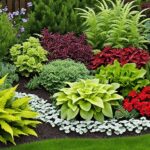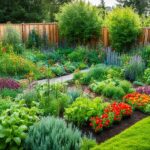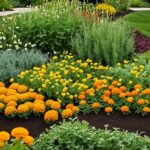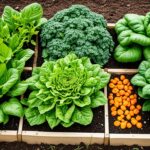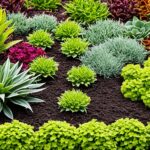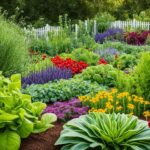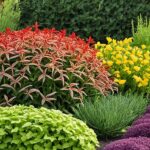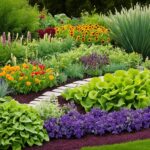glenn.imagepros
Companion Planting in Small Spaces
Having a backyard garden is rewarding. It gives you fresh produce, lowers stress, and makes your outdoor area look great. But, if your small garden is tight, you can still boost your gardening with companion planting. This guide will show you how companion planting in small spaces works, help you pick the right plants, and give tips for your compact garden.
Imagine turning your small backyard or balcony into a lush, productive spot. By learning about companion planting, you can find the best efficient plant pairings. This way, you can create a balanced small space gardening setup, even in busy urban gardening areas. Ready to learn more about container companion planting? Let’s get started.
Key Takeaways
- Companion planting can maximize limited space in small gardens or containers
- The right plant pairings can deter pests and enrich the soil
- Vertical gardening techniques like trellises and hanging baskets can boost productivity
- Interplanting and succession planting strategies can provide a continuous harvest
- Careful plant selection and spacing considerations are key for small space gardening
The Benefits of Companion Planting in Small Spaces
Companion planting in small spaces is great for gardeners with limited space. By pairing plants wisely, you make the most of every inch in your garden. Each plant helps the others grow and thrive, keeping pests away and making the soil healthier.
Efficient Use of Limited Space
With companion planting, plants work together in harmony. Some plants act as a natural mulch, keeping the soil cool and moist. Others grow upwards, making the most of your space. This way, you can grow many plants in a small area, giving you a big harvest from a little garden.
Pest Deterrence and Soil Enrichment
Companion plants are key to keeping pests away and improving soil health. Some plants naturally keep pests off your crops. Others fix nitrogen in the soil or attract good insects, keeping your garden balanced and healthy. This means you use fewer chemicals and have a better garden.
Using companion planting in your small garden makes it both productive and sustainable. With smart plant choices, you can fight pests and improve your soil. Enjoy a beautiful, thriving garden that uses space well and is good for the planet.
Choosing Suitable Plants for Companion Planting
Choosing the right plants for a small-space garden is key. Look for plants that are small but still produce well together. Breeders are always coming up with new compact plant varieties for urban gardening and small space plant selection. This makes it easier to pick the perfect plants for your garden.
Think about the plants you like or buy often. Use those in your garden plans. This way, you’ll get a good harvest and use your space well.
| Compact Vegetable Varieties | Compact Herb Varieties | Compact Flower Varieties |
|---|---|---|
| Bush Beans | Dwarf Basil | Marigolds |
| Patio Tomatoes | Compact Thyme | Nasturtiums |
| Miniature Eggplants | Dwarf Rosemary | Petunias |
With the right small space plant selection, you can make a garden that’s both beautiful and efficient. Companion planting helps you use your space well.
Vertical Gardening Techniques
Vertical gardening techniques are a big help when you have little garden space. You can use trellises, cages, and hanging baskets to grow plants like cucumbers, tomatoes, and pole beans up high. This saves ground space for other plants. Living walls and herb towers are great for small gardens too. They let you grow many herbs and greens in a small, vertical space.
Trellises, Cages, and Hanging Baskets
Trellises, cages, and hanging baskets are great for making the most of your vertical space. They support plants that grow up, saving ground space for other plants. You can also make your garden look beautiful and work well by adding these vertical elements to your design.
Living Walls and Herb Towers
For a really compact way to garden vertically, think about a living wall or an herb tower. These systems let you grow many plants, from leafy greens to herbs, in a small area. Living walls are perfect for a lush look on a wall or fence. Herb towers are a smart way to keep your favorite herbs close by.
“Vertical gardening techniques are a game-changer for small-space gardeners, allowing you to maximize your growing potential and create visually stunning displays.”
Interplanting and Intercropping Strategies
Using interplanting and intercropping can make your small garden work harder. These methods boost productivity and create a healthier garden. They make your garden more vibrant and full of life.
Pairing Plants with Complementary Growth Habits
For interplanting to work, pair fast-growing plants with slower ones. Plant quick veggies like radishes or lettuce among bigger plants like broccoli or peppers. This way, you can pick the quick plants early, without hurting the growth of the bigger ones.
Intercropping means mixing plants that grow well together. For example, put shallow-rooted veggies with deep-rooted ones. This reduces competition for water and nutrients. Each plant gets what it needs without taking too much space. This method makes your garden more efficient and full of food.
| Interplanting | Intercropping |
|---|---|
| Planting fast-growing crops between slower-growing plants | Pairing plants with complementary growth habits |
| Allows you to harvest quick-maturing crops before larger plants need more space | Minimizes competition for resources and maximizes space utilization |
| Examples: Radishes or lettuce between broccoli or peppers | Examples: Shallow-rooted veggies with deep-rooted ones |
Learning interplanting and intercropping can turn your small garden into a productive spot. You’ll get lots of fresh, healthy food in a small space.
Succession Planting for Continual Harvest
Learning succession planting is a big win for gardeners with limited space. This method keeps your garden full of fresh food all season. It makes the most of every inch of your garden.
Succession planting means having seedlings ready to go when you harvest the first crop. By planting quick-growing veggies like radishes, salad greens, and peas at different times, you get a steady supply of fresh food. This way, you can enjoy homegrown produce from spring to fall.
In small gardens, every bit of space counts. With careful planning and knowing how fast different plants grow, you can make the most of your space. This means a constant flow of fresh produce from your garden.
“Succession planting allows me to make the most out of my limited gardening space. By having seedlings ready to go as soon as one crop is done, I can keep my garden in constant production and enjoy a steady supply of fresh produce all season long.”
Whether you’re an experienced gardener or a beginner, adding succession planting to your garden plan is a smart move. It helps you grow more food for longer and keeps your garden busy all season.
Succession planting is a key strategy for gardeners with limited space. It lets you use your garden space well and enjoy a steady harvest all season.
Companion Planting in Small Spaces
Companion planting is key for a successful garden in small spaces. By pairing plants wisely, gardeners can use space well, keep pests away, and improve soil quality.
Recommended Plant Combinations
Some top pairings for small gardens include:
- Planting shade-tolerant crops like lettuce and basil with taller plants like tomatoes to use space well.
- Combining flowering plants like marigolds and nasturtiums with vegetables to draw in good bugs and keep pests away.
- Pairing plants that fix nitrogen like legumes with heavy eaters like peppers or corn to boost soil health.
Spacing and Soil Considerations
When planning your garden, think about how much space and soil each plant needs. Good spacing lets each plant get what it needs to grow well. High-quality soil is key for a successful garden.
| Plant | Spacing | Soil Needs |
|---|---|---|
| Tomatoes | 18-24 inches | Well-draining, nutrient-rich |
| Lettuce | 6-12 inches | Moist, nutrient-rich |
| Basil | 12-18 inches | Moist, well-draining |
By thinking about these things, gardeners can make a great companion planting system. This makes the most of small spaces.
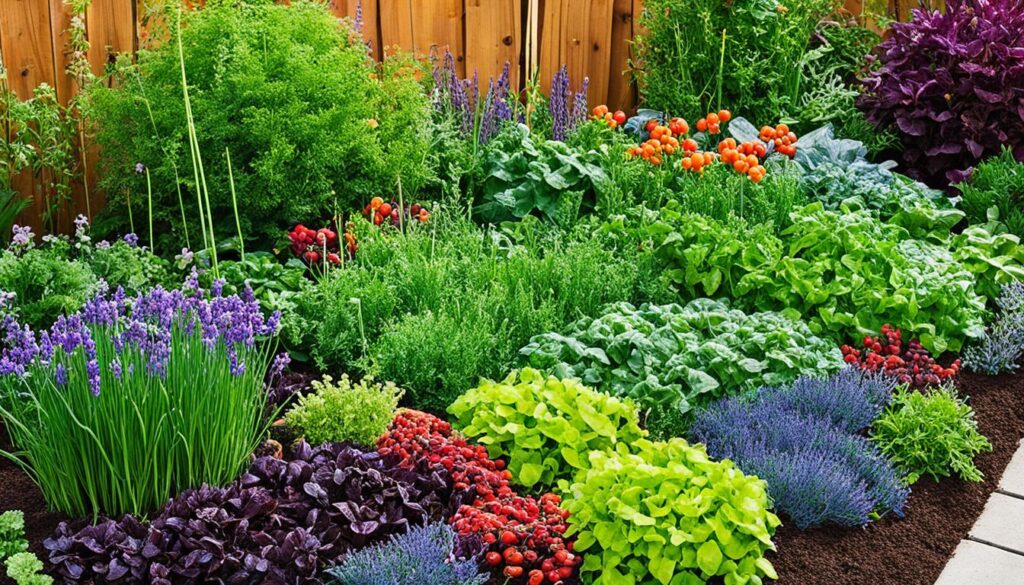
“Companion planting is a time-honored tradition that can work wonders in small-space gardens, helping to create a more diverse, productive, and pest-resistant growing environment.”
Container Gardening for Small Spaces
If you’re short on outdoor space, container gardening can change the game for your small space gardening efforts. This method lets you grow a variety of plants, from bright flowers to patio gardening and balcony gardening crops, easily.
Choosing the Right Containers
When picking containers for your container gardening, think about what your plants need. Big, deep pots are great for climbing plants and larger plants. Smaller pots are better for herbs, greens, and smaller vegetables.
- Look for pots with good drainage to prevent waterlogging and ensure healthy root growth.
- Choose materials that suit your climate, such as terracotta for hot, dry regions or plastic for cooler climates.
- Opt for self-watering containers to simplify your gardening routine and reduce the risk of over- or under-watering.
| Container Size | Suitable Plants |
|---|---|
| 5-10 gallons | Tomatoes, peppers, eggplants, bush beans, dwarf fruit trees |
| 2-5 gallons | Herbs, leafy greens, radishes, carrots, compact vegetable varieties |
| 1-2 gallons | Herbs, strawberries, small lettuce varieties, microgreens |
By picking the right containers for your small space gardening, you can make the most of your space. You’ll enjoy a full harvest, even in tiny outdoor areas.
Maximizing Light and Soil Quality
In small space gardening, getting your plants the right light and soil is key. They need enough light and nutrient-rich soil to grow well. This is vital for a successful urban garden or small space garden.
Place your plants where they get the right amount of sunlight. Most veggies and herbs do best with lots of small space garden lighting. If the sun isn’t enough, add artificial lights to help your plants.
Soil quality is also crucial. Use soil that’s full of nutrients and drains well to help your plants grow strong. Soil health affects how tasty your food is and how much you’ll get. So, make sure to create the best soil for your urban gardening projects.
Soil Preparation Tips
- Conduct a soil test to identify any nutrient deficiencies
- Amend the soil with organic matter, such as compost or aged manure
- Ensure proper drainage by incorporating sand or perlite, if needed
- Maintain the optimal pH range for your chosen plants
| Vegetable | Ideal Soil pH |
|---|---|
| Tomatoes | 6.0 – 6.8 |
| Carrots | 6.0 – 6.5 |
| Lettuce | 6.0 – 7.0 |
By making sure your plants get enough light and have healthy soil, you can make your small space garden lighting and urban gardening thrive. This means a bigger and better harvest.
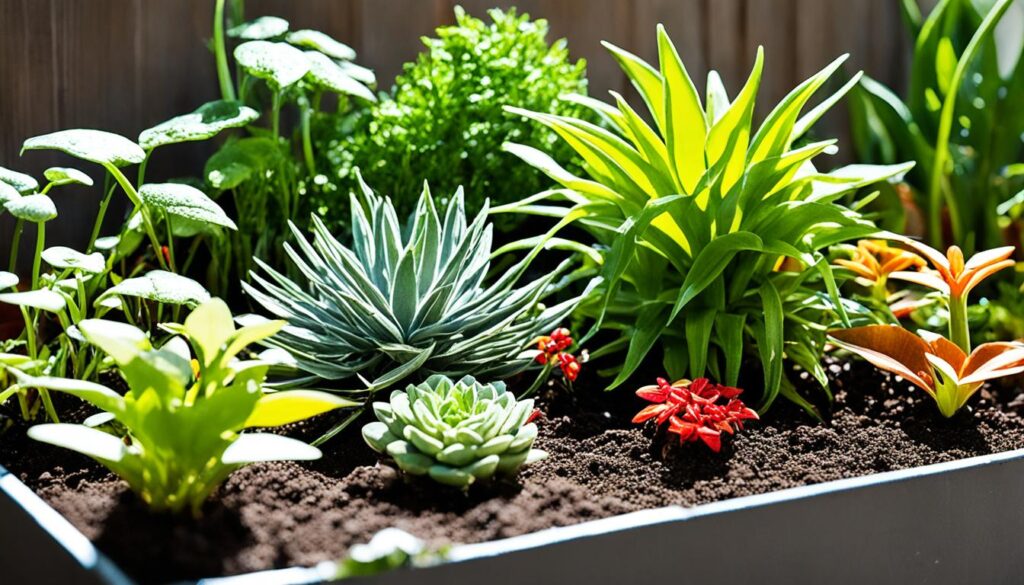
“The key to a successful small-space garden is understanding the unique needs of your plants and providing them with the necessary resources to thrive.”
Conclusion
Using small space gardening and companion planting can turn even tiny outdoor spots into a lush, productive garden. You can make the most of your space by planning where plants go and what they need. This way, you get a lot of fresh, homegrown food.
This article shares tips like vertical gardening and planting together to help urban gardeners use their space well. By picking plants that work well together and arranging them smartly, you can make a garden that looks good and grows food without pests. It also makes the soil better and keeps you eating fresh, healthy food all year.
Start with companion planting to make your small space gardening dreams come true. With some creativity and hard work, you can have a lovely, full garden right in your city.
FAQ
What are the benefits of companion planting in small spaces?
Companion planting in small spaces has many advantages. It makes the most of limited space, keeps pests away, and enriches the soil. By pairing plants wisely, you can make your small garden thrive and produce well.
How do I choose suitable plants for companion planting in a small garden?
Pick plants that are compact and don’t take up too much space. Choose varieties that grow well together. Focus on plants you use or buy often to make your garden work better.
What vertical gardening techniques can I use in a small space?
Use trellises, cages, and hanging baskets for plants like cucumbers and tomatoes. These methods save ground space. Living walls and herb towers are great for small gardens, letting you grow many plants vertically.
How can interplanting and intercropping strategies benefit my small garden?
Interplanting lets you grow fast crops like radishes among slower ones like broccoli. This way, you can harvest the quick crops early. Intercropping pairs plants that grow well together, reducing competition and using space better.
How can succession planting help me extend my small garden’s productivity?
Succession planting keeps your garden producing non-stop. By having seedlings ready to go in, you can keep harvesting fresh food all season. Quick-growing veggies like radishes and peas are perfect for this method in small gardens.
What are some recommended plant combinations for companion planting in small spaces?
Plant lettuce and basil under taller plants like tomatoes to use space well. Make sure to think about how much space and soil each plant needs in your small garden.
How can container gardening benefit my small-space companion planting setup?
Container gardening is great for small gardens, fitting into small areas like balconies or windowsills. Choose containers that match your plants’ sizes and needs for their growth.
What factors should I consider to maximize light and soil quality in my small garden?
Make sure your plants get enough light and good soil for their health. Place them where they get the right sunlight. Use rich, well-draining soil to help your plants grow well.
Source Links
Advanced Techniques in Companion Planting
Are you ready to boost your gardening skills? Learn about advanced companion planting techniques to make your garden thrive. This article will show you how to pair plants for better growth and use vertical gardening. You’ll discover the secrets of expert-level companion planting.
Key Takeaways
- Unlock the full potential of companion planting with expert-level strategies
- Learn how to create diverse and productive plant communities
- Discover the benefits of vertical gardening and polycultures
- Understand the importance of crop rotation and succession planting
- Explore the wonders of aquaponic and hydroponic gardening
Are you ready to change your garden and improve your growing skills? Dive into advanced companion planting to make your garden better. Let’s explore new techniques that will change your gardening journey.
Understanding the Basics of Companion Planting
Companion planting is a way to make your garden better by putting plants together that help each other. It’s about creating a garden where plants work together. This method can make your garden more productive and healthy.
What is Companion Planting?
It’s about picking plants that grow well together. They help each other fight pests and stay healthy. Think of it as a garden party where each plant is a friend that makes the party better for everyone.
Benefits of Companion Planting
Companion planting has many benefits for your garden. Here are some main advantages:
- Improved soil health by encouraging beneficial microorganisms and nutrient cycling
- Enhanced plant growth through nutrient sharing and pest deterrence
- Increased growing efficiency by maximizing available space and resources
- Reduced weed and pest pressure by creating a diverse, balanced ecosystem
- Improved water usage through the strategic placement of plants
Learning about companion planting helps you make a garden that works well with nature.
“Companion planting is like a well-choreographed dance, where each plant plays a unique role in supporting the others.”
Mastering Plant Combinations
Choosing the right plants to grow together can greatly improve your garden. Expert plant pairings offer many benefits, like keeping pests away and making flavors better. Let’s look at two classic proven companion plant combinations that have been successful for a long time.
Tomatoes and Basil: A Harmonious Duo
Tomatoes and basil are a perfect match in the garden. Basil’s strong smell keeps pests like aphids and spider mites away from tomatoes. Plus, basil might make your tomatoes taste even better, making your garden and meals more enjoyable.
Carrots and Onions: Mutual Pest Deterrence
Carrots and onions work well together too. Onions’ strong smell keeps carrot flies away from carrots. At the same time, carrots help shade and protect onions, keeping weeds down.
Trying out these and other proven companion plant combinations can make your garden better. With the right plant pairings, you can have a garden that’s easy to take care of and full of life. Mastering companion planting means enjoying more from your garden and a healthier environment.
“The secret to a successful garden often lies in the delicate dance of plant relationships.”
Attracting Beneficial Insects
Companion planting is more than just fighting pests. It’s about making a garden where helpful bugs can live and thrive. By adding certain flowers and plants, you can draw in a variety of insects that eat common garden pests.
Flowers that Attract Predatory Insects
Adding flowers like calendula, cosmos, and marigolds to your garden can attract wasps and hoverflies. These insects love to eat aphids. They are great at keeping your plants safe from pests without the need for chemicals.
Creating a Diverse Habitat
Having many different plants in your garden makes it look better and helps more insects live there. Ladybugs, lacewings, and parasitic wasps are some of the good bugs that will come to live in a garden with lots of plants. They help control aphids, mites, and other pests.
By attracting beneficial bugs and creating a balanced garden ecosystem with companion planting for pest control, you can keep your garden healthy. This way, you don’t need to use harsh chemicals. It’s good for your plants and helps the environment.
advanced companion planting techniques
While basic companion planting is key, there are more advanced strategies for gardeners. These include expert-level techniques like vertical gardening and polycultures. They also cover creating specialized companion planting guilds.
Using vertical space is a smart move. Trellises and cages let you grow more plants in less space. This saves ground space and helps plants work well together.
Polycultures are another advanced way to plant. They mix different plants together to create a balanced garden. This approach helps control pests, improves soil, and makes gardens stronger.
Creating companion planting guilds is a top-level strategy. These groups of plants help each other out. They share nutrients, fight pests, and help with pollination. By picking the right plants for your guilds, your garden can do better than ever.
Learning advanced companion planting takes time and watching closely. By trying new methods and seeing what works for you, you can make your garden amazing. It will be full of life and ready for anything.
Vertical Gardening and Polycultures
Gardening fans looking to use less space can try vertical gardening and polycultures. These methods make the most of your space and help create a strong, varied plant world.
Maximizing Space with Vertical Gardening
Vertical gardening is a smart way to save space and boost your garden’s health and output. It lets you grow plants like beans, peas, or tomatoes up high. These plants use space well and can shade plants below, helping them grow better.
This setup also draws in good bugs, making your garden healthier.
Benefits of Polycultures
- Polycultures, or growing many plants together, mimic nature. They make your garden stronger and more varied.
- With different plants, you can keep pests away, draw in helpful bugs, and create a garden that looks after itself.
- They also make the soil better, help nutrients move around, and increase your garden’s productivity.
| Technique | Benefits |
|---|---|
| Vertical Gardening |
|
| Polycultures |
|
Using vertical gardening and polycultures, gardeners can make the most of their space. They create a garden that’s full of life, healthy, and strong.
Creating Companion Planting Guilds
Take your gardening to the next level with companion planting guilds. These plant groups mimic nature, offering balance and benefits. They help with pest control and nutrient sharing, making your garden thrive.
At the core of a companion planting guild is the careful selection of plants that help each other. Picture a garden where plants work together, keeping pests away, improving pollination, and sharing nutrients. This approach creates a beautiful plant community.
To make your own companion planting guild, follow these tips:
- Choose plants that grow well together and need similar sunlight.
- Add plants that keep pests away or attract good bugs.
- Use a mix of tall, medium, and short plants to use space well.
- Put plants together that give different nutrients to the soil, making a healthy garden.
Using companion planting guilds opens up new possibilities in synergistic gardening. Your garden will be more productive, tough, and beautiful. You’ll create a plant community that grows well on its own.
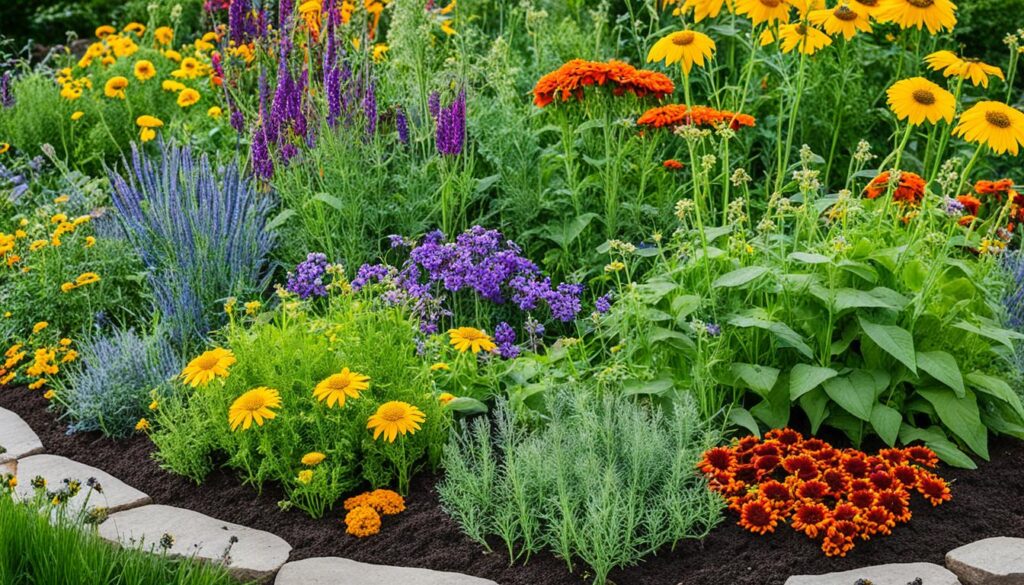
Success with companion planting guilds comes from watching, trying, and knowing your garden’s ecosystem. Dive into synergistic gardening and see your garden’s true potential.
Crop Rotation and Succession Planting
As a gardener, learning about sustainable gardening is key to a thriving garden. Crop rotation and succession planting are two important techniques. They can greatly improve your gardening success.
Importance of Crop Rotation
Crop rotation means changing where you grow different crops each year. This stops pests and diseases from building up in one spot. By moving crops around, you break the life cycle of pests, making your plants healthier and your garden more diverse.
Succession Planting for Continuous Harvest
Succession planting is great when used with companion planting. It means planting different crops at different times for a steady harvest. This way, your garden stays productive longer, giving you fresh produce for more months.
Using crop rotation and succession planting in your sustainable gardening practices has many benefits. You’ll see better soil health, fewer pests, and a garden that’s more diverse and strong. These techniques help you garden better and keep your garden going all season.
“Successful gardening is not just about what you plant, but how you manage the overall system.”
Raised Bed and Square Foot Gardening
Take your gardening to new heights with raised bed and square foot gardening. These methods give you more control over your soil and help you use space well. They’re great for anyone looking to improve their garden.
Raised bed gardening lets you tailor your growing spaces to what your plants need. You can pick the best soil, drainage, and nutrients for your plants. It’s perfect for gardens with bad soil or little space, as you can fill the beds with top-quality soil.
Adding square foot gardening to raised beds makes the most of your space. It divides your garden into small squares, letting you grow many plants in a small area. Each square fits a certain number of plants, so you can grow a variety of things without taking up too much room.
| Gardening Method | Key Benefits |
|---|---|
| Raised Bed Gardening |
|
| Square Foot Gardening |
|
Using raised bed and square foot gardening together can make your garden productive and beautiful. These methods show the power of intensive gardening methods. Try them out and see how your garden can flourish.
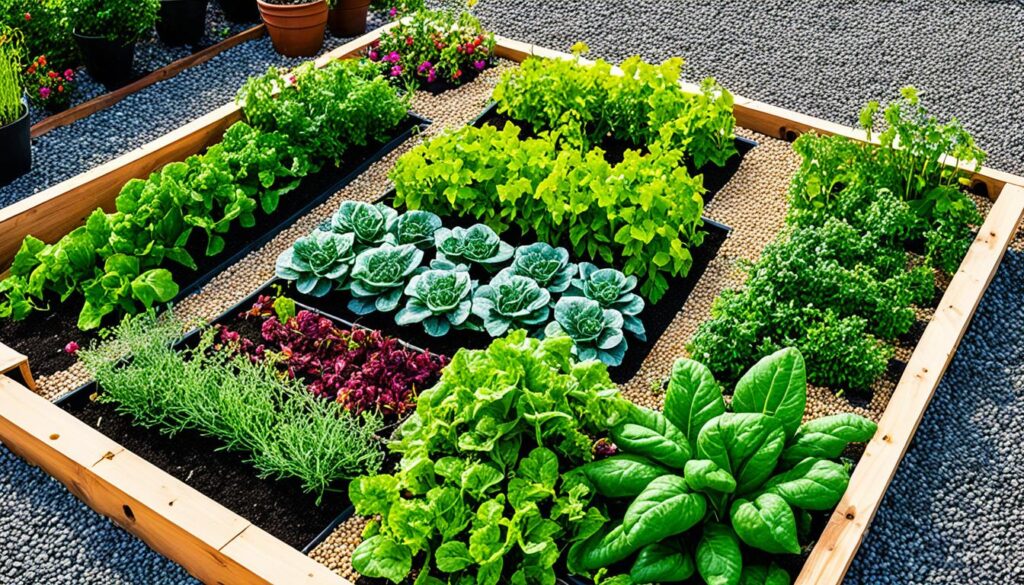
“Gardening is a matter of your enthusiasm holding up until your back gets used to it.” – Unknown
Aquaponics and Hydroponics
For those looking to explore beyond traditional gardening, aquaponics and hydroponics are exciting options. These systems use water, not soil, to feed plants with nutrients. This changes how we grow our food.
Understanding Aquaponic Systems
Aquaponics combines fish and plants in a special way. Fish waste feeds the plants, and plants clean the water for the fish. This system uses resources well, making it popular for city and small gardens.
Advantages of Hydroponic Gardening
Hydroponics lets growers control what plants get from nutrients. It sends a special mix of nutrients right to the roots. This method is great for growing certain crops in places with poor soil or tough growing conditions.
Choosing aquaponics or hydroponics means embracing the future of gardening. These water-based systems let you fully use your gardening space. They take your gardening to new levels.
“Aquaponics and hydroponics are redefining the way we think about gardening, offering a sustainable and innovative approach to growing our own food.”
Conclusion
Companion planting is a way to make your garden better for your plants. It helps them grow strong and healthy by using the principles of companion planting. This method makes your garden a place where plants help each other out.
It’s not a magic solution for all gardening problems, but it’s very helpful. It cuts down on the need for harmful chemicals. Start with a few plants, try different mixes, and watch how they do. Then, change your plans as needed to help your garden.
Starting your companion planting adventure is exciting. Remember, the summary of advanced companion planting, key takeaways, and final thoughts on companion gardening show how great this method is. By helping your plants work together, you create a garden that’s full of life and in harmony with nature.
FAQ
What is companion planting?
Companion planting is a way to make your garden better by putting certain plants together. This method helps keep pests away and boosts pollination. It makes your garden a healthy place.
What are the key benefits of companion planting?
Companion planting has many benefits. It makes soil healthier, helps plants grow better, and uses water wisely. It also keeps weeds and pests away, making your garden more efficient.
Can you give examples of successful plant pairings?
Yes, some plants work great together in the garden. For example, tomatoes and basil are a good pair. Basil keeps pests away from tomatoes and makes them taste better. Carrots and onions also work well together. Onions keep carrot flies away, and carrots shade the onions, fighting weeds.
How can companion planting attract beneficial insects?
Adding flowers like calendula, cosmos, and marigolds attracts wasps and hoverflies that eat aphids. A garden with many plants draws ladybugs, lacewings, and wasps. These insects help control pests like aphids and mites.
What are some advanced companion planting techniques?
Advanced techniques include vertical gardening and polycultures. Creating guilds and using crop rotation and succession planting are also good methods. Trying different techniques helps find what works best in your garden.
How can raised bed and square foot gardening be integrated with companion planting?
Raised beds help control soil better, and square foot gardening uses space well. These methods can work with companion planting for a productive garden. They make your garden look good and grow more.
What are the benefits of aquaponics and hydroponics in companion planting?
Aquaponics and hydroponics offer new ways to garden. They use water to feed plants instead of soil. In aquaponics, fish and plants help each other, with fish waste feeding the plants. Hydroponics lets you control plant nutrition well, making it good for growing certain crops.
Source Links
How to Start a Sustainable Garden: A Beginner’s Guide
Do you want to make your gardening greener? Starting a sustainable garden can seem hard, but it’s a journey that’s good for you and the planet. Learn how to turn your yard into a lush, self-sustaining garden that matches your values and gives you lots of fresh produce.
Key Takeaways
- Understand the principles of sustainable gardening and its benefits for the environment.
- Identify the right location for your garden based on sunlight and shade considerations.
- Learn how to prepare the soil and create raised garden beds to enhance fertility.
- Discover the best plants to grow in a sustainable garden, including perennials and fruit trees.
- Implement water conservation strategies like rainwater harvesting and mulching.
Starting a sustainable garden is more than just growing food. It’s about making a space that helps nature’s balance. By using eco-friendly methods, you can lower your environmental impact, save resources, and enjoy a garden that keeps giving. Are you ready to learn how to create a sustainable garden that will thrive for years?
Understanding Sustainable Gardening
Sustainable gardening is all about making a garden that’s good for the planet. It helps reduce your carbon footprint, builds healthy soil, and brings in good bugs. Plus, you get to enjoy fresh, healthy food all year round.
What is a Sustainable Garden?
A sustainable garden uses organic ways to grow and saves resources. It works like nature to make the most of things like compost and mulch. This way, you get lots of good stuff and use less of everything else.
Benefits of Sustainable Gardening
Switching to a sustainable garden has lots of perks, like:
- Less carbon footprint from not using synthetic stuff
- Better soil health with organic stuff and natural helpers
- More bugs that help your garden grow
- Always having fresh, healthy food at home
- Saving money compared to regular gardening
Choosing eco-friendly gardening means you get lots of benefits. You help make the planet healthier and more resilient.
“Sustainable gardening is not just a trend – it’s a way of life that benefits both you and the environment.”
Choosing the Right Location
Choosing the right spot for a sustainable garden is crucial. It’s all about finding a place that fits the sunlight and shade needs of your plants. This is key to a successful garden.
Sunlight and Shade Considerations
Most veggies need at least 6 hours of sunlight every day. But, some like leafy greens can do well in partial shade. Make sure your garden spot has good drainage and isn’t near trees with deep roots. Also, being close to water and your kitchen is handy.
- Look for a location that receives at least 6 hours of direct sunlight per day.
- Ensure the area has good drainage and is not dominated by heavy tree roots.
- Choose a spot that is close to a water source and your kitchen for easy access.
- Research the specific sunlight requirements for the vegetables and plants you wish to grow.
By picking a spot that meets the garden location tips and choosing a garden site with enough sunlight for vegetables, you’re setting up for a successful garden. This will give you a rich harvest for many years.
Preparing the Soil
Healthy, nutrient-rich soil is key for a thriving garden. Proper soil prep helps plants grow well and cuts down on chemical use. Here are some steps to get your soil ready for plants.
Creating Raised Garden Beds
Building raised garden beds is a great idea. These beds let you control the soil and drainage. Just frame an area with wood or stone and fill it with good potting mix or soil with compost.
This design helps with air flow and warms the soil early, giving plants a great start.
Enhancing Soil with Compost and Mulch
Adding organic matter is crucial, whether you till or use raised beds. Compost boosts soil structure, nutrients, and water retention. Spread 2-4 inches of compost and mix it well into the soil.
Using a thick layer of organic mulch also helps. It keeps soil moist, controls weeds, and enriches the soil as it breaks down.
| Soil Preparation Technique | Benefits |
|---|---|
| Raised Garden Beds |
|
| Compost Addition |
|
| Organic Mulch |
|
Using these soil prep methods in your garden plan helps plants thrive.
Selecting Plants for a Sustainable Garden
Choosing the right plants is key to a sustainable garden. Go for native and adapted plants that love your local climate. These plants need less water and food, making them great for the planet.
Adding a mix of vegetables, herbs, and flowers will draw in pollinators and beneficial insects. This helps create a healthy garden. Plus, you’ll get lots of fresh produce and beautiful flowers.
| Plant Type | Benefits for Sustainable Gardening |
|---|---|
| Native Plants | Adapted to local climate conditions, requiring less water and maintenance |
| Disease-Resistant Hybrids | Reduce the need for pesticides and fungicides, promoting a healthier garden |
| Pollinator-Friendly Flowers | Attract bees, butterflies, and other beneficial insects to support a thriving ecosystem |
By picking plants that fit your sustainable gardening goals, you can make a beautiful, easy-care garden. It will look great and help the environment in your area.
“The true essence of a sustainable garden lies in the plants you choose to cultivate. By embracing native and adapted varieties, you can create a resilient, low-impact landscape that thrives with minimal intervention.”
Incorporating Perennials and Trees
Creating a sustainable garden is easier with perennial plants and fruit trees or bushes. These plants bring many benefits that make your garden better over time.
Advantages of Perennial Plants
Perennials like perennial flowers, herbs, and grasses are great for your garden. They come back every year, needing less care and water. They also help improve soil health as they grow.
- Reduced maintenance and watering needs
- Improved soil structure and fertility
- Consistent, long-lasting plant coverage
- Diverse habitats for beneficial insects and pollinators
Fruit Trees and Bushes
Adding fruit trees and berry bushes to your garden is smart. They give you lots of tasty food and help the environment. These plants store carbon, protect wildlife, and make your garden’s climate better.
| Fruit Tree | Fruit Bushes |
|---|---|
| Apple | Blueberry |
| Pear | Raspberry |
| Peach | Blackberry |
| Cherry | Currant |
Using perennial plants for sustainable gardens and growing fruit trees and bushes is smart. You get the amazing benefits of perennials. Your garden will be a beautiful, self-sustaining place for years.
Water Conservation Strategies
Water conservation is key in sustainable gardening. By using water-saving techniques, gardeners can lessen their environmental impact. They also ensure their gardens stay healthy and resilient over time.
Rainwater Harvesting
Rainwater harvesting is a great way to save water. Gardeners can collect rain in barrels or cisterns. This reduces their need for municipal water and uses rainwater for plants.
This method not only saves water but also helps refill groundwater and ease the load on water systems.
Mulching and Ground Cover
Mulching and ground cover are also vital for saving water. Organic mulch, like wood chips or leaves, keeps soil moist, cutting down on watering needs. Ground covers, such as low-growing plants or clover, stop evaporation and keep soil cool. This saves even more water.
By using these strategies, your garden will use less water and stay healthy. Rainwater harvesting, mulching, and ground cover are easy ways to save water. They help make your garden more eco-friendly.
| Water-Saving Technique | Benefits |
|---|---|
| Rainwater Harvesting |
|
| Mulching and Ground Cover |
|
“Sustainable gardening is not just about growing beautiful plants; it’s about preserving the balance of our ecosystem and safeguarding our precious natural resources.” – Jane Doe, Sustainable Gardening Expert
Attracting Pollinators and Beneficial Insects
Creating a sustainable garden is more than just growing plants. It’s about building a home for a variety of beneficial insects. Attracting bees, butterflies, and hummingbirds, as well as insects that eat garden pests, is key. This keeps your garden healthy and productive over time.
Planting different flowers that bloom at various times is a great way to draw in pollinators. This gives them food all season long. Sunflowers, lavender, zinnias, and coneflowers are great choices for your garden.
Your garden can also be a home for insects that eat pests. Ladybugs, lacewings, and praying mantises are some examples. They help control aphids and caterpillars without the need for chemicals.
To support pollinators and beneficial insects, try these tips:
- Plant a mix of native and non-native flowers that bloom at different times.
- Provide places for insects to live and survive the winter, like log piles or brush piles.
- Avoid using broad-spectrum pesticides, which can harm good insects too.
- Add cover crops and groundcover to help the soil and its ecosystem.
By welcoming pollinators and beneficial insects, you’re making your garden sustainable and balanced. It will flourish year after year.
| Pollinator-Friendly Plants | Beneficial Insects |
|---|---|
| Sunflowers, Lavender, Zinnias, Coneflowers | Ladybugs, Lacewings, Praying Mantises |
“A garden is only as rich and beautiful as the integral health of the system; pollinators are essential to the system’s health.” – Émilie Wapnick
Companion Planting
Starting your sustainable gardening journey? Consider companion planting. This method means growing certain plants close together to help and protect each other. It makes your garden a thriving, self-sustaining place.
Companion planting uses symbiotic plant relationships found in nature. Some plants give out nutrients that help their neighbors. Others keep pests away from your garden. By picking the right plants to grow together, you make your garden more productive and resilient.
Plants that Work Well Together
- Tomatoes and basil: Basil keeps aphids and other pests away from tomatoes.
- Marigolds and vegetables: Marigolds’ strong smell keeps pests away, making them great for your veggies.
- Radishes and carrots: Radishes loosen the soil and bring up nutrients for carrots.
- Beans and corn: Beans fix nitrogen in the soil, which helps corn plants grow.
Using companion planting makes your garden healthy and strong. It needs fewer chemicals and helps your plants grow better. Try different plant combinations and see how your garden thrives with these natural partnerships.
“Companion planting is not just about growing plants together; it’s about creating a harmonious and balanced ecosystem in your garden.”
Sustainable Garden Maintenance
Keeping a sustainable garden is an ongoing task that needs careful planning. Two important methods to help your garden stay healthy are succession planting and crop rotation.
Succession Planting Techniques
Succession planting means planting seeds or seedlings at different times during the growing season. This way, you get a steady flow of fresh produce. By planting at different times, you can have a long harvest, not just a short one.
- Plant early, mid, and late-season varieties of the same crop for a prolonged harvest.
- Replace spent plants with new seedlings to fill gaps and keep your garden productive.
- Try fast-growing, short-season crops to fill in between longer-maturing plants.
The Benefits of Crop Rotation
Crop rotation means growing different plants in the same spot over time. This method has many benefits, including:
- Improved soil fertility: Different crops need different nutrients, so rotating them helps the soil stay rich.
- Reduced pest and disease pressure: Changing what you grow makes it harder for pests and diseases to spread.
- Enhanced biodiversity: A mix of crops supports more beneficial insects and microorganisms, creating a healthy garden ecosystem.
Using these sustainable garden practices keeps your garden productive, strong, and good for the environment for many years.
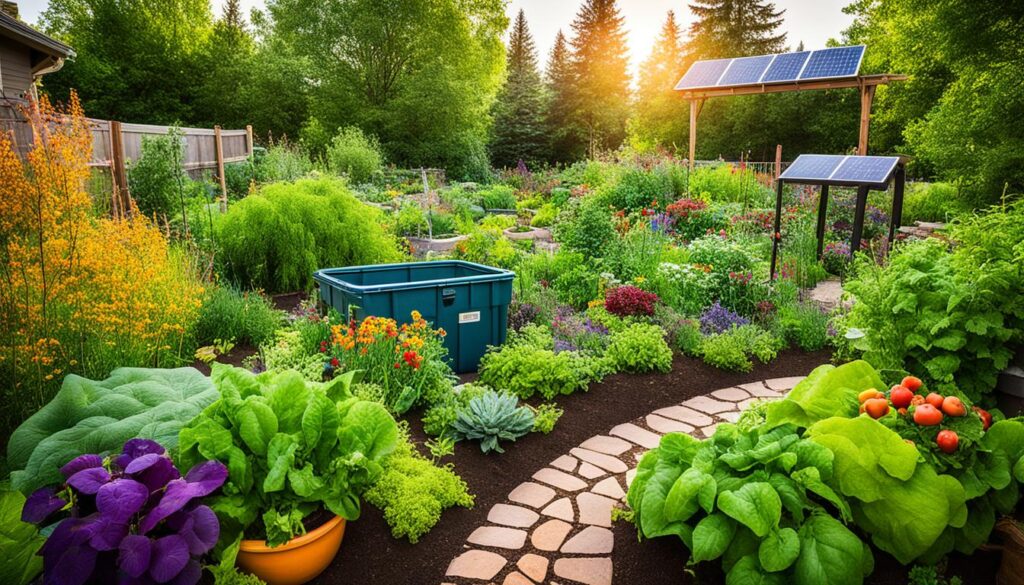
Vertical Gardening
Vertical gardening is a smart way to make your garden both sustainable and productive. It lets you use your space better by growing plants up instead of out. With things like trellises and cages, you can have a garden that takes up less room but is full of life.
One big plus of vertical gardening techniques is how they save space. You can grow plants like tomatoes and peas up the wall instead of on the ground. This makes your garden more productive and looks great too.
Also, growing climbing plants up high has other perks. It helps with air flow, keeps diseases away, and makes picking easier. Plants up high are less likely to get sick and are easier to take care of.
- Use strong supports like trellises or cages for your climbing plants.
- Pick plants that do well up high, like tomatoes, peas, and cucumbers.
- Keep your plants tidy by pruning and training them to grow up the supports.
- Add plants around the base for a pretty and useful garden.
With vertical gardening techniques, you can do amazing things with your garden. Use every inch of space, increase your harvest, and make a garden that shows off your love for the planet and smart gardening.
Saving Seeds for Next Season
At the end of the season, collecting and saving seeds is a great way to save money. It lets you grow your favorite varieties year after year. This method, called seed saving, is key for gardeners who love heirloom plants and want a steady supply of their favorite crops.
It’s especially good for saving seeds from peas, beans, tomatoes, and peppers. These seeds are easy to dry and store. Then, you can replant them next season for the same tasty flavors you love.
Seed Saving Tips
- Identify the best-performing and healthiest plants in your garden.
- Allow the seed-bearing fruits or pods to fully mature on the plant.
- Carefully harvest the seeds, ensuring they are clean and free of debris.
- Dry the seeds thoroughly in a cool, well-ventilated area.
- Store the dried seeds in an airtight container in a cool, dry place.
By saving seeds, you save money and keep your favorite heirloom varieties alive. This is vital for a sustainable garden and the long-term success of your plants.
Remember, drying and storing seeds right is key. With a bit of care, you can grow from your saved seeds year after year.
“Saving seeds is a time-honored tradition that connects us to the land and ensures the continued existence of our favorite plant varieties.”
Sustainable Garden
Creating a sustainable vegetable garden means thinking about many things to make it work well and be good for the planet. It doesn’t matter if you’re new to gardening or have been doing it for years. Learning about seasonal vegetable gardening and changing your garden with the seasons can make a big difference. It helps you grow a garden that feeds your family and helps the environment.
Planning Your Sustainable Veggie Patch
Start by looking at how much sun, soil quality, and water your garden spot gets. Using raised beds or containers with good soil is a great way to make sure your plants are happy. Adding perennials and trees makes your garden more diverse and strong.
Growing Through the Seasons
It’s important to change what you grow in your garden with the seasons for a good harvest. Plant different types of crops for cool and warm weather to always have fresh food. Keep your garden healthy by watering, mulching, and controlling pests.
| Season | Vegetables to Grow | Maintenance Tips |
|---|---|---|
| Spring | Lettuce, spinach, peas, radishes | Prepare soil, plant cool-weather crops, practice succession planting |
| Summer | Tomatoes, peppers, cucumbers, beans | Water regularly, mulch to retain moisture, monitor for pests |
| Fall | Broccoli, cauliflower, carrots, beets | Plant cool-weather crops, continue watering and mulching |
By planning your garden and changing it with the seasons, you can have a garden that’s full of life and gives you fresh food all year. Always check with local gardening experts and follow sustainable gardening tips to make sure your garden does well for a long time.

Conclusion
Starting a sustainable garden is a great way to help the planet, grow your own food, and feel closer to nature. By picking the right spot, making healthy soil, drawing in good bugs, and saving water, you can make a garden that grows well year after year. This guide gives you the tips and tricks to start your own sustainable garden at home.
Choosing to garden sustainably is good for the earth and makes you feel proud and connected to nature. From planning your garden to saving seeds for later, every step helps make your garden better for the planet. By gardening sustainably, you get to enjoy lots of fresh produce and help make the world greener.
Whether you’re new to gardening or have been doing it for years, this guide’s tips will help you make a garden that’s good for you and the earth. Enjoy growing your own food, helping bees, and living more sustainably.
FAQ
What is a sustainable garden?
A sustainable garden uses eco-friendly ways to save resources and increase positive outputs like compost and homegrown food. It combines organic methods, saves resources, and mimics nature.
What are the key benefits of sustainable gardening?
Sustainable gardening cuts down your carbon footprint, builds healthy soil, and attracts good insects. It also gives you a steady supply of fresh, nutritious food.
How do I choose the right spot for my sustainable garden?
Pick a spot that gets enough sunlight, drains well, is close to water, and near your kitchen. Most veggies need 6 hours of direct sun. Leafy greens can grow in partial shade.
How do I prepare the soil for a sustainable garden?
Start with healthy, rich soil for a great garden. You can till the soil and add compost, or use raised beds with good soil or compost. Mulch around plants keeps moisture in, stops weeds, and improves soil over time.
What plants should I choose for my sustainable garden?
Pick plants that fit your local climate and soil. Native plants need less care and are tough. Hybrid varieties that fight diseases can cut down on pesticides. Mix veggies, herbs, and flowers to draw in pollinators and beneficial insects.
How can I make my garden more water-efficient?
Use less water in your garden. Collect rainwater, use drip irrigation, and mulch to lower evaporation. Ground covers like wood chips keep soil moist.
How can I attract pollinators and beneficial insects to my garden?
Plant flowers that bloom a lot to feed butterflies, bees, and other pollinators. These insects help control pests naturally, so you use fewer chemicals.
What is companion planting, and how can it benefit my sustainable garden?
Companion planting means growing plants together to help each other. Some plants give nutrients to others, while others keep pests away or attract good insects. Choosing the right plants together makes your garden better and more resilient.
How can I save seeds from my sustainable garden?
Saving seeds from your garden saves money and lets you grow your favorites again. Focus on saving seeds from peas, beans, tomatoes, and peppers. If you dry and store them right, you can replant them next year.
Source Links
- https://www.thegardencontinuum.com/blog/grow-your-own-a-beginners-guide-to-sustainable-vegetable-gardening-at-home – Grow Your Own: A Beginner’s Guide to Sustainable Vegetable Gardening at Home
- https://bonnieplants.com/blogs/garden-fundamentals/organic-gardening-for-beginners – Organic Gardening for Beginners | How to Start a Garden
- https://kellogggarden.com/blog/gardening/how-to-start-a-sustainable-garden/ – How to Start a Sustainable Garden
Common Mistakes in Companion Planting and How to Avoid Them
Have you ever tried companion planting and seen your plants struggle? This gardening technique can boost your crops and fight pests, but it’s not easy. What mistakes do gardeners often make, and how can you dodge them?
Key Takeaways
- Companion planting can enhance crop yields and control pests, but requires understanding plant needs and interactions
- Shading, resource depletion, and allelopathic effects are some of the most common companion planting problems
- Proper plant spacing, soil preferences, and pest/disease management are crucial for successful companion planting
- Avoiding overcrowding and understanding cross-pollination issues are also important factors
- With the right knowledge, you can reap the benefits of companion planting and avoid its common pitfalls
What is Companion Planting?
Companion planting, also known as interplanting, is a way to grow different plants together. It helps plants work well with each other, like they do in nature. By choosing the right plants to grow together, you can improve pest control, make crops taste better, and increase soil health.
The Basics of Companion Planting
Companion planting is about knowing how different plants work together. You match plants based on their needs and how they help each other. This means putting tall plants with short ones, picking plants that need the same nutrients, or using some to keep pests away.
This method is all about making plants live together well. Each plant adds something to the garden. By gardening this way, you create a healthy, balanced garden that takes care of itself.
“Companion planting is not just about growing plants together – it’s about creating a harmonious and productive garden ecosystem.”
Whether you’re new to gardening or have been doing it for years, learning about companion planting can change your garden. It leads to more food, less use of chemicals, and a healthier garden.
Benefits of Companion Planting
Companion planting is a gardening method that brings many benefits to home gardeners. It helps with pollination, makes crops taste better, and keeps weeds away. This approach turns your garden into a lively ecosystem. Let’s look at the benefits of companion planting and why you should use it in your garden.
Attracting Beneficial Insects
One big plus of companion planting is drawing in pollinators. By placing certain plants together, you can attract bees, butterflies, and other helpful insects. This boosts pollination, making your crops grow better and taste sweeter.
Enhancing Crop Flavor
Companion planting also makes your crops taste better. Some plants mix well and change the flavor and smell of fruits and veggies. This is great for gardeners who want their food to be fresh and tasty.
Adding Nutrients to the Soil
Another good thing about companion planting is it helps the soil. Some plants, like legumes, fix nitrogen, which helps other plants grow. This means you might use fewer chemicals and your plants will be healthier.
Controlling Weeds
Companion planting can also help with controlling weeds. By choosing plants that stop weeds from growing, you spend less time pulling them out. This makes gardening easier and more enjoyable.
These benefits of companion planting explain why it’s popular with organic gardeners. By using this method, you can have a garden that’s beautiful, easy to care for, and full of food.
Disadvantages of Improper Companion Planting
Companion planting has many benefits like helping with pollination, making crops taste better, and fighting weeds. But, it’s important to know the downsides of not doing it right. The risks of companion planting, drawbacks of companion planting, and potential issues with companion planting can really affect your garden’s success.
One big worry is how plants fight over water and nutrients. If they’re too close, they can’t get what they need to grow well. This can make some plants grow poorly or even stop another plant from growing. It’s important to plan and space them out right.
Another issue is when taller plants shade the shorter ones. This means the shorter plants don’t get enough sunlight. They won’t grow as well or produce as much. To avoid this, think about how big each plant will get and where to put them.
Some plants also release chemicals that can slow down or even kill other plants. These risks of companion planting can be a big problem. It’s important to know which plants do this and not put them together.
“Proper planning and research are key to avoiding the drawbacks of companion planting and ensuring a thriving, harmonious garden ecosystem.”
By knowing and dealing with these risks of companion planting, gardeners can make the most of this method. They can have a garden that’s diverse, productive, and good for the planet.
Planting Tall Plants Near Short Ones
Putting tall plants next to short ones can cause shading issues. Taller crops like corn, sunflowers, or tomatoes can block sunlight from reaching plants like lettuce, radishes, or spinach. This can stunt the growth and lower the yield of the shorter plants.
To prevent shading, think about the mature size of each plant and give them enough space. This ensures all plants get enough sunlight. Trellising vining crops is also a good way to make sure all plants get enough light.
Managing Plant Heights in Companion Planting
Here are some tips for managing plant heights and avoiding shading:
- Put taller plants on the north or west side to avoid shadows on shorter ones.
- Use a mix of tall, medium, and low-growing plants for a layered look and balanced light.
- Prune or trim tall plants often to keep them from getting too tall and shading others.
- Think about using vertical growing methods, like trellises or cages, to keep tall plants off the ground and let more sunlight in.
By planning the placement and management of tall and short plants, you can prevent shading. This way, all your plants will do well in the garden.
Heavy Feeders Depleting Resources
In the world of companion planting, knowing how plants use nutrients is key. Plants like tomatoes, squash, and peppers need a lot of nutrients to grow big and produce well. These heavy feeding plants can use up the soil’s nutrients fast. This leaves plants like spinach or herbs without enough to grow.
To stop this nutrient competition, pair plants with similar needs or choose light-feeding companions. This way, you make sure all your plants get the nutrients they need to be healthy.
Adding compost or slow-release fertilizers to the soil is a good idea. It helps keep the nutrients balanced. This lets your plants live together without one taking all the nutrients.
| Heavy Feeding Plants | Lighter Feeding Companions |
|---|---|
| Tomatoes | Spinach, Basil |
| Squash | Radishes, Marigolds |
| Peppers | Lettuce, Carrots |
By knowing what your plants need and managing soil fertility in companion planting, you can make a garden where all plants thrive. No one plant will take all the nutrients, making a balanced garden.
Allelopathic Plants Inhibiting Growth
When you think about planting together, know about allelopathy. Some plants release chemicals that slow down or stop other plants from growing. This is called allelopathy and can be a big problem for gardeners and farmers.
Plants like the black walnut tree, rhododendrons, and some veggies like brassicas and fennel can be allelopathic. If you put these near other plants, they can really hurt their growth or even kill them. It’s important to know which plants don’t get along to plant well together.
Examples of Allelopathic Plants and Incompatible Combinations
- Black walnut (Juglans nigra) – Releases juglone, a compound toxic to many plants, including tomatoes, peppers, and potatoes.
- Rhododendrons – Produce grayanotoxins that can hinder the growth of neighboring plants.
- Brassicas (e.g., cabbage, broccoli, cauliflower) – Contain glucosinolates that can suppress the growth of other vegetables.
- Fennel (Foeniculum vulgare) – Releases anethole, which can inhibit the growth of tomatoes, beans, and other plants.
When you’re planning your garden or farm, make sure to check for allelopathic plants. Avoid putting these allelopathic plants near plants that inhibit growth or incompatible companion plants. This will help your garden grow well together.
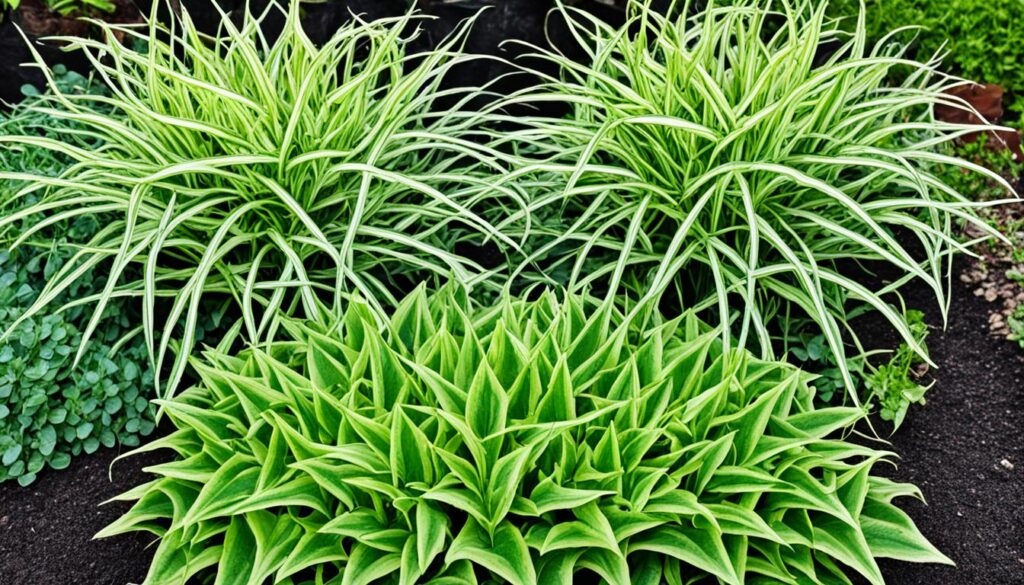
Overcrowding and Poor Spacing
Beginner gardeners often make the mistake of over-planting and not spacing plants correctly. As plants grow, they need enough space to reach their full potential. If they’re too close, they can fight over roots and sunlight, leading to smaller plants and more pests.
It’s crucial to space plants right when you plant them together. Use the numbers on seed packets or tags to guide you. Wider spacing helps prevent problems like over-planting and incorrect plant spacing.
- Avoid cramming plants too close together, as this can lead to competition for resources and diminished growth.
- Respect the individual space requirements of each plant species in your companion planting setup.
- Leave enough room between plants to allow for their full development, both above and below ground.
Plan your companion plantings with the importance of plant spacing in mind. This way, you’ll get the most out of this gardening method and have a healthy garden.
| Plant | Recommended Spacing |
|---|---|
| Tomatoes | 24-36 inches apart |
| Carrots | 1-2 inches apart |
| Basil | 12-18 inches apart |
| Marigolds | 12-15 inches apart |
Remember, getting plant spacing right is key to your garden’s success. Avoid over-planting and make sure to space plants correctly. This way, you’ll have a garden that’s full of life and benefits from companion planting.
Common Mistakes in Companion Planting
Companion planting can boost your garden’s productivity and balance. But, it has its pitfalls. Knowing the common mistakes helps you get the most out of it and avoid problems.
One big mistake is planting tall crops too close to short ones. This can block sunlight, hurting the short plants. Make sure to plan your garden so all plants get enough sun.
Another mistake is pairing plants that eat too much soil nutrients. These plants might grow well at first but can harm others later. Check how much nutrients your plants need and use compost or organic fertilizers to help.
- Avoid planting tall crops too close to shorter ones to prevent shading issues
- Be mindful of heavy feeders that can quickly deplete the soil’s resources
- Steer clear of allelopathic plants that release chemicals that inhibit the growth of nearby plants
- Ensure adequate spacing to prevent overcrowding and allow for proper plant development
Some plants release chemicals that can slow down other plants’ growth. These are called allelopathic plants. Black walnut trees, eucalyptus, and some Brassica family members are examples. Make sure to check if your plants could harm others before planting them together.
Overcrowding is another big mistake. It can lead to competition for resources, more pests and diseases, and smaller plants. Give your plants enough space to grow big and healthy.
By avoiding these common mistakes, you can have a garden that’s full of life and benefits from companion planting.
Considering Plant Needs and Requirements
When planning your garden, think about what each plant needs. Things like matching plant needs in companion planting and knowing what plants need to grow well are key. These factors can make your garden a success or a failure.
Soil Preferences, Water Needs, and Growth Habits
Plants like tomatoes do well in certain soils, while lettuce prefers others. It’s important to know these differences. This way, one plant won’t take over and harm the others.
It’s also key to know how each plant grows. Pairing tall plants with shorter ones makes sure they don’t block each other. By matching their needs, you create a garden that works well together.
| Plant Characteristic | Examples | Compatibility Considerations |
|---|---|---|
| Soil pH Preference | Blueberries (acidic), Carrots (neutral) | Avoid planting blueberries and carrots together, as they have conflicting soil pH needs. |
| Water Needs | Succulents (low), Hydrangeas (high) | Pair plants with similar water requirements to prevent one from outcompeting the other for moisture. |
| Growth Habit | Pole Beans (climbing), Lettuce (low-growing) | Companion plant pole beans with low-growing crops like lettuce to avoid shading and overcrowding. |
By understanding plant requirements for companion planting, gardeners can make their plants grow better together. This way, they support each other’s growth and productivity.
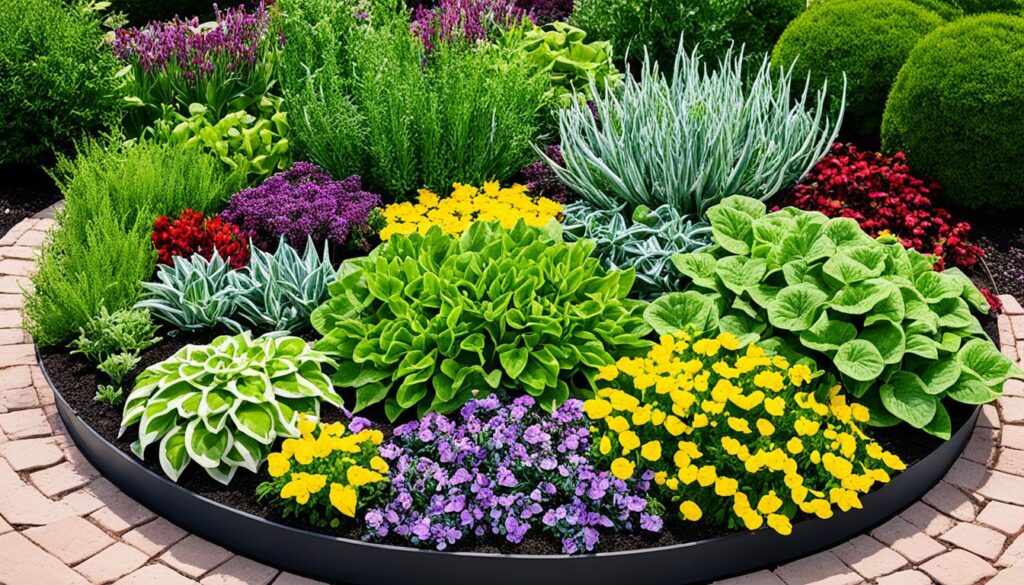
“Successful companion planting requires careful consideration of the individual needs and characteristics of each plant species.”
Attracting Same Pests and Diseases
When you plant crops together, you need to think about avoiding pests and diseases. If you grow plants that pests or diseases target, these problems can spread easily. This can cause big damage to your garden.
To prevent this, mix different types of plants in your garden. This way, you make it harder for pests and diseases to find one plant to attack. It’s like making a puzzle for them, so they can’t easily spread from one plant to another.
Before you start planning your garden, look into the pests and diseases each plant can face. Check if they have the same enemies. Then, pick plants that won’t share these pests and diseases. This smart planning helps you keep pests and diseases away from your garden.
“Diversifying your garden with a variety of plants is a key strategy to prevent the spread of pests and diseases in your companion planting system.”
Think about the pests and diseases each plant can face before you plant. This way, you can make a garden that works well together. It will be less likely to have big pest and disease problems. With this careful planning, your garden will stay healthy and full of life all season.
Cross-Pollination Issues
Companion planting is a great way to garden, but watch out for cross-pollination issues. Some plants can mix their genes when grown close together. This can lead to new, unexpected plant types. It can also mess up your garden plans and make saving seeds hard.
To prevent this, know which plants can cross-pollinate. This lets you arrange your garden to reduce cross-pollination risks. By doing this, you keep your plants pure and enjoy the benefits of companion planting.
Identifying Cross-Pollinating Plants
Some plants that can cross-pollinate include:
- Tomatoes and peppers
- Squash and pumpkins
- Broccoli and cabbage
- Corn and certain bean varieties
Make sure to check the plants you want to grow and their compatibility. This way, you can avoid unwanted cross-pollination. Being proactive helps you enjoy companion planting while keeping your plants pure.
| Plant Combination | Cross-Pollination Risk | Recommended Spacing |
|---|---|---|
| Tomatoes and Peppers | High | At least 10 feet apart |
| Squash and Pumpkins | Moderate | At least 6 feet apart |
| Broccoli and Cabbage | Low | 3-4 feet apart |
| Corn and Beans | Low | 4-6 feet apart |
Understanding cross-pollination in companion planting and avoiding unintended hybrids in companion planting helps you grow a successful garden. It meets your gardening goals.
Conclusion
Companion planting is a great way to make your garden better, but you need to watch out for mistakes. Knowing about plant spacing, nutrient needs, and how plants affect each other is key. This helps you grow plants that work well together.
Understanding how to avoid common mistakes is important for gardeners. Make sure to think about what each plant needs and avoid those that use too many resources. Also, be careful with plants that can harm others.
By avoiding these mistakes, you can get many benefits from companion planting. You’ll see better pollination, tastier crops, and fewer weeds and pests. With the right knowledge and planning, your garden can flourish with companion planting.
FAQ
What is companion planting?
Companion planting is a way to make your garden better by pairing certain plants together. It helps keep pests away, brings in good bugs, makes the soil richer, and grows more food in a small area.
What are the benefits of companion planting?
It helps plants grow better by attracting helpful insects and making the food taste better. It also adds nutrients to the soil and keeps weeds down by filling up the space.
What are the potential drawbacks of improper companion planting?
If not done right, companion planting can cause problems. Plants might fight over water and nutrients, taller plants can block sunlight to the shorter ones, and some plants can slow down the growth of others.
How can planting tall crops near shorter ones cause issues?
Taller plants like corn or tomatoes can block sunlight from reaching plants like lettuce or spinach. This can hurt their growth.
What problems can heavy-feeding crops cause when paired with light feeders?
Plants like tomatoes or squash use a lot of nutrients. If they’re near plants that need less, like spinach, they can leave those plants without enough food.
How can allelopathic plants impact neighboring plants?
Some plants release chemicals that can slow down or even kill nearby plants. This is called allelopathy.
Why is it important to provide adequate spacing for companion plants?
If plants are too close, they can fight over resources like sunlight and roots. Giving them enough space helps them grow well.
What other factors should be considered when choosing companion plants?
Think about what each plant needs, like the soil type, how much water it needs, and how it grows. This makes sure they can live together well.
How can pests and diseases spread in a companion planting system?
If you have plants that pests or diseases target together, problems can spread easily. It’s better to mix up the types of plants you grow.
What issues can arise from cross-pollination in companion plantings?
When plants are close together, they can cross-pollinate. This can create new plant types that you might not want.
Source Links
The Ultimate Guide to Sustainable Gardening Practices
Are you ready to turn your garden into a sustainable haven? Sustainable gardening is more than a trend. It’s a way to make a space that’s good for nature and supports local wildlife. This guide will show you how to garden organically, working with nature.
You’ll learn how to improve soil health and save water. These eco-friendly tips are great for any garden, big or small. They help create a space that’s good for the environment and beautiful to look at.
Key Takeaways
- Sustainable gardening promotes ecosystem health and biodiversity
- Organic methods reduce reliance on harmful chemicals
- Water conservation techniques help preserve precious resources
- Soil improvement is crucial for long-term garden success
- Eco-friendly practices support local wildlife and pollinators
- Sustainable gardens can be created in any space, big or small
Introduction
Sustainable gardening is changing how we connect with nature. It blends organic methods with saving resources to lessen harm to the environment. By working with nature, you can make a garden that’s good for you and the earth.
There are many benefits to sustainable gardening that go beyond your yard. You’ll get better health and a clearer mind, and you’ll help cut down on pollution. Your garden will be a safe spot for local animals and stop soil from washing away, making your area better for everyone.
“Sustainable gardening is not just a trend; it’s a commitment to our planet’s future.”
To start sustainable gardening, make smart choices. Think about using plants that are native to your area. They fit well with your climate and need less care. By choosing wisely now, you’re helping to make a better environment for the future.
| Sustainable Gardening Practice | Environmental Impact |
|---|---|
| Using native plants | Supports local ecosystems |
| Organic pest control | Reduces harmful chemical usage |
| Water conservation techniques | Preserves water resources |
| Composting | Reduces waste and enriches soil |
Are you ready to begin your sustainable gardening journey? Let’s look at the key ideas and actions that will turn your garden into a green haven.
What is Sustainable Gardening?
Sustainable gardening is a way to make gardens friendly to the planet. It uses eco-friendly practices and saves resources. It aims to create gardens that live in harmony with nature, help local ecosystems, and lessen harm to the environment.
Choosing sustainable gardening means doing more good for the earth. It’s about using plants native to your area, saving water, and cutting down on waste. This approach lets you have beautiful gardens while thinking about the planet’s well-being.
Let’s look at some key parts of sustainable gardens:
- Natural pest control
- Water conservation techniques
- Composting
- Low-maintenance design
These elements help make gardens that are good for the environment and look great. By using these eco-friendly methods, you help make the planet healthier. And you get to enjoy gardening more.
| Traditional Gardening | Sustainable Gardening |
|---|---|
| Chemical pesticides | Natural pest control |
| Frequent watering | Water conservation |
| Synthetic fertilizers | Composting |
| High-maintenance exotic plants | Native, low-maintenance plants |
By choosing sustainable gardening, you’re not just growing plants. You’re helping to create a healthier ecosystem in your backyard. It’s a fulfilling way to connect with nature and make a positive change for the environment.
Soil Health and Improvement
Healthy soil is key to a successful garden. The quality of your soil affects your garden’s success. By focusing on soil health, you help your plants thrive.
Forget synthetic fertilizers that are bad for the planet. Choose organic fertilizers to feed your soil naturally. Composting is a great way to turn waste into food for your plants.
Start a compost pile with kitchen scraps, leaves, and grass clippings. This saves money and gives you organic fertilizer. Your plants will love the extra nutrients!
“The soil is the great connector of lives, the source and destination of all.” – Wendell Berry
If you’re worried about peat bog conservation, try coir-based compost. It’s a green choice that helps protect peat bogs. These bogs are important for taking in carbon dioxide from the air.
- Test your soil regularly to understand its needs
- Add organic matter to improve soil structure
- Use cover crops to prevent erosion and add nutrients
- Avoid tilling to preserve soil structure and beneficial organisms
By focusing on soil health, you’re doing more than just growing plants. You’re building a sustainable future for your garden and the earth.
Water Conservation Techniques
Sustainable gardening is all about using water wisely. By using rainwater harvesting and efficient irrigation, you can make a big difference. These methods save water and help your plants grow well.
Collecting rainwater is a big step for garden sustainability. Place rain barrels under your gutters to store water for dry times. This simple action cuts down on your need for city water.
Watering your plants at the right time is important. Do it early in the morning or late in the evening to cut down on evaporation. This way, your plants get the most from every drop.
Efficient irrigation systems are key for saving water. Drip irrigation and soaker hoses send water straight to the roots, avoiding waste. These systems use 50% less water than old-style sprinklers.
“The best time to plant a tree was 20 years ago. The second best time is now.” – Chinese Proverb
Mulching is great for saving water too. Putting organic mulch around your plants keeps moisture in and stops weeds from growing. It’s good for saving water and keeping your plants healthy.
| Water Conservation Technique | Water Savings | Ease of Implementation |
|---|---|---|
| Rainwater Harvesting | Up to 1,300 gallons per year | Moderate |
| Drip Irrigation | 30-50% compared to sprinklers | Easy |
| Mulching | 10-30% reduction in water needs | Very Easy |
Using these water-saving tips, you’re not just saving water – you’re making your garden more resilient and sustainable. Your plants will do well, and you’ll see the benefits in your garden’s health and your water bill.
Organic Pest Control Methods
Organic gardening is more than just skipping chemicals. It’s about making a garden where pests naturally stay away. This approach keeps your garden healthy without using harmful chemicals.
First, focus on soil health. Healthy soil grows strong plants that can fight off pests. Also, changing what you grow in each spot each year helps break the pest cycle.
Then, use physical barriers to protect your garden. Mulches, row covers, and fences can keep pests away. For smaller pests, sticky traps or picking them off by hand works well.
Biological controls use nature to fight pests. Plant flowers that attract good insects. Ladybugs, lacewings, and praying mantises are great at controlling pests.
| Pest | Natural Predator | Attracting Plant |
|---|---|---|
| Aphids | Ladybugs | Dill |
| Caterpillars | Parasitic Wasps | Yarrow |
| Slugs | Ground Beetles | Perennial Grasses |
If other methods don’t work, try botanical solutions. Neem oil and diatomaceous earth can help against tough pests. But remember, the aim is balance, not total pest removal. A few pests are okay in a healthy garden.
Companion Planting
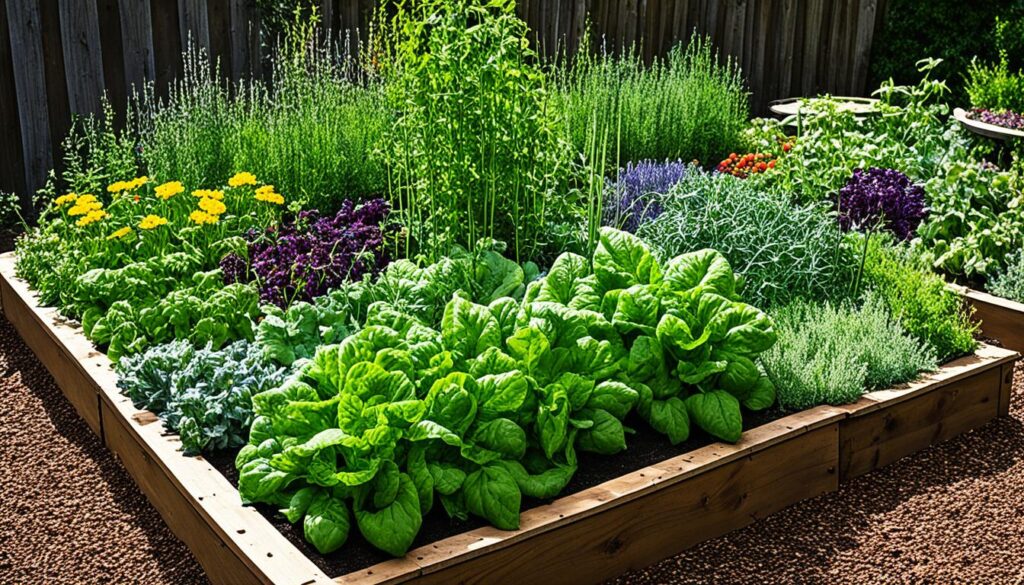
Companion planting is a smart way to make your garden better. It means putting plants together to help each other grow. This method uses plant pairs to keep pests away naturally.
Think of your garden as a community where plants support each other. Some plants guard against pests. Others add nutrients to the soil. By knowing these plant relationships, you can create a self-sustaining garden.
Here’s a quick guide to some effective plant combinations:
| Plant | Companion | Benefit |
|---|---|---|
| Tomatoes | Basil | Repels flies and mosquitoes |
| Carrots | Onions | Deters carrot flies |
| Corn | Beans | Beans fix nitrogen for corn |
| Lettuce | Chives | Improves lettuce flavor |
Try these pairings in your garden and see how well they do together. Companion planting is all about garden harmony. It helps your plants grow better and cuts down on chemical use. Your garden will be healthier for it!
Crop Rotation and Diversity
Crop rotation and plant diversity are essential for sustainable gardening. By changing what you grow in each spot every year, you improve soil health and fight pests. This method is great for managing soil nutrients.
Want a better garden? Mix it up! Plant different crops in various spots each season. This strategy keeps soil rich and reduces pests. It also lets you try new plants and keeps your garden interesting.
Here’s a simple crop rotation plan you can use:
| Year 1 | Year 2 | Year 3 | Year 4 |
|---|---|---|---|
| Leafy Greens | Root Vegetables | Legumes | Fruiting Vegetables |
| Lettuce, Spinach, Kale | Carrots, Beets, Radishes | Peas, Beans | Tomatoes, Peppers, Squash |
Don’t forget about native plants! They’re resilient, need less water, and help local wildlife. Try to have 70% native plants in your garden. This supports plant diversity and creates a wildlife-friendly space.
By rotating crops and embracing diversity, you’re not just growing food. You’re creating a thriving ecosystem in your backyard!
Raised Bed and Vertical Gardening
Want to make the most of your garden? Raised bed and vertical gardening are great options. They help you grow more in less space, ideal for small yards or city living.
Raised beds give you control over the soil and drainage. You can pick the perfect soil mix for your plants. Plus, they’re easier to reach and maintain.
Vertical gardening lets you grow plants upwards. Use walls, fences, or trellises to save space. It also makes your garden look more interesting.
Vertical gardening transformed my tiny balcony into a lush oasis. I now grow herbs, tomatoes, and even cucumbers in just a few square feet!
Using raised beds and vertical gardening together can be very effective. Here’s how they compare to traditional gardening:
| Feature | Traditional Garden | Raised Bed + Vertical |
|---|---|---|
| Space Efficiency | Low | High |
| Soil Control | Limited | Full |
| Maintenance | More demanding | Easier |
| Yield per sq ft | Lower | Higher |
By choosing these gardening methods, you’ll have a garden that’s both beautiful and productive.
Permaculture Principles
Permaculture gardening is a new way to design a sustainable ecosystem. It copies nature’s patterns to make a garden that works well with its environment. Let’s look at key permaculture principles to turn your garden into a self-sustaining place.
Begin by watching your garden. See how water moves, where sunlight hits, and which plants do well. Use this info to plan your garden smartly. Use rainwater tanks or sun traps to save energy. Every part of your garden should help with more than one thing.
Follow the “no waste” rule. Compost kitchen scraps, use leaves as mulch, and turn old items into planters. This helps the planet and feeds your garden. Pick plants that give you something back, like food, medicine, or beauty.
“The problem is the solution.” – Bill Mollison, co-founder of permaculture
Choose plants that keep pests away or improve the soil. This cuts down on the need for outside help and makes your garden stronger. Use things like solar lights or hand tools to lessen your garden’s impact on the environment.
| Permaculture Principle | Application in Your Garden |
|---|---|
| Observe and Interact | Study microclimates, soil types, and native plants |
| Catch and Store Energy | Install solar panels, create compost bins |
| Obtain a Yield | Plant fruit trees, herbs, and vegetables |
| Apply Self-Regulation | Use companion planting, encourage beneficial insects |
| Use Renewable Resources | Harvest rainwater, use manual garden tools |
| Produce No Waste | Compost organic matter, upcycle materials |
By using these permaculture principles, you’ll make a garden that’s not just sustainable, but also regenerative. Your hard work will help the planet and give you a garden full of life and beauty.
Wildlife and Organic Fertilizers
Creating a wildlife-friendly garden is a great way to help local ecosystems. You can attract many creatures by offering food, water, and shelter. Start by planting native flowers, shrubs, and trees that have nectar and berries.
Install bird feeders, baths, and nesting boxes to welcome birds.
Natural fertilizers are key in wildlife-friendly gardening. They feed your plants without hurting insects or polluting water. Compost is a top choice for gardeners, adding important nutrients to soil. You can make it from kitchen scraps and yard waste.
Other natural fertilizers include:
- Bone meal: Rich in phosphorus, ideal for root development
- Seaweed extracts: Packed with trace minerals and growth hormones
- Worm castings: Excellent for improving soil structure
Using wildlife-friendly gardening and natural fertilizers makes your garden a thriving ecosystem. This approach helps local wildlife and leads to healthier plants and soil. Your garden becomes a sanctuary for nature, offering a beautiful and sustainable place for everyone to enjoy.
Seed Saving and Sustainable Garden Design
Learn the art of seed saving to keep your garden diverse. By saving seeds from top plants, you keep unique varieties alive. Heirloom seeds, with their rich flavors and traits, are a treasure to save.
Planning a sustainable garden is more than making it look good. It’s about building a balanced ecosystem that needs little care. Think about how much sun, water, and space each plant needs when designing your garden. This way, you use resources well and keep up with less work.
Make special spots in your garden for different plants. Use permaculture zones to make the most of resources. Put crops you use a lot near your house. Let perennials and plants that take care of themselves be in the outer areas.
“A well-designed garden is a sustainable ecosystem, working in harmony with nature.”
Follow these tips for your garden:
- Group plants with similar water needs together
- Use vertical spaces for climbing plants
- Implement rainwater harvesting systems
- Create wildlife-friendly areas
- Utilize companion planting techniques
By saving seeds and planning sustainably, you’re not just gardening. You’re building a strong, caring ecosystem. This helps you and the planet.
Edible Landscaping and No-Dig Gardening
Turn your garden into a feast for the eyes and the stomach with edible landscaping. This approach mixes beauty with practicality, making food forests in your backyard. By adding fruit trees, berry bushes, and colorful vegetables, you get a beautiful garden that also produces food.
Pair your edible landscape with no-dig gardening, a growing trend among sustainable gardeners. This method helps keep the soil healthy. Instead of tilling, which can harm the soil, no-dig gardening adds organic layers on top.
- Start with a layer of cardboard to suppress weeds
- Add compost, leaf mold, and well-rotted manure
- Plant directly into this rich, organic layer
No-dig gardening works like nature, letting worms and microorganisms improve the soil. These tiny helpers make the soil better for plants and increase nutrients. This means healthier plants and more food with less work.
“The soil is the great connector of lives, the source and destination of all.” – Wendell Berry
By using edible landscaping and no-dig gardening, you make a sustainable, productive, and beautiful garden. This way, you feed your family and help local ecosystems. You also keep the soil healthy for future generations.
Urban and Seasonal Gardening
Sustainable gardening isn’t just for big yards. City folks can live green with smart container gardening. Even small spaces like balconies, rooftops, and windowsills can become green spots with the right ideas.
Container gardening is great for city living. Pick pots of different sizes for herbs, veggies, and flowers. Mix plants for looks and make the most of your small space.
Plan your garden for all seasons to grow food all year. Choose plants that do well in each season. For example, eat kale and spinach in winter, and enjoy tomatoes and peppers in summer.
“Urban gardening isn’t just about growing food; it’s about cultivating community and connecting with nature in concrete jungles.”
Make your garden last longer with easy tricks. Cold frames keep seedlings safe from frost, letting you plant early. Polytunnels are great for keeping warm crops going into fall.
| Season | Container-Friendly Crops | Growing Tips |
|---|---|---|
| Spring | Lettuce, Radishes, Peas | Use lightweight potting mix for quick drainage |
| Summer | Tomatoes, Peppers, Basil | Provide ample sunlight and regular watering |
| Fall | Kale, Chard, Carrots | Add mulch to retain soil moisture |
| Winter | Microgreens, Herbs, Garlic | Move containers to protected areas or indoors |
With container gardening and growing all year, you can have fresh food and greenery anywhere, anytime.
Native Plants and Organic Weed Control
Embrace the beauty of indigenous plant species in your garden! These native plants support local ecosystems and need less upkeep. By picking plants that do well in your area, you’ll have a garden that uses less water, fertilizer, and pest control.
Keeping your garden weed-free without chemicals is important. Here are some organic ways to manage weeds:
- Mulching: Apply a thick layer of organic mulch around your plants
- Hand-pulling: Remove weeds by the root before they spread
- Cover crops: Plant fast-growing crops to suppress weed growth
It’s key to avoid chemical herbicides to protect beneficial organisms and keep soil and water clean. Your garden will be healthier for choosing eco-friendly ways.
| Indigenous Plant Species | Benefits | Natural Weed Management |
|---|---|---|
| Black-Eyed Susan | Attracts pollinators, drought-resistant | Mulching with wood chips |
| Purple Coneflower | Medicinal properties, supports wildlife | Hand-pulling young weeds |
| Butterfly Weed | Monarch butterfly magnet, low maintenance | Planting cover crops like clover |
By using these sustainable methods, you’ll have a garden that works with nature. Your efforts will help the environment and make your backyard more lively!
DIY Projects and Gardening with Children
Get your hands dirty with sustainable garden crafts! It’s a fun way to reduce waste and help local ecosystems. You can make compost bins from old pallets, craft rain barrels from food-grade drums, or design insect hotels with natural materials.
Educational gardening lets kids learn about sustainability and how to grow food. By getting them involved, you help them connect with nature. This also teaches them eco-friendly habits that will stick with them forever.
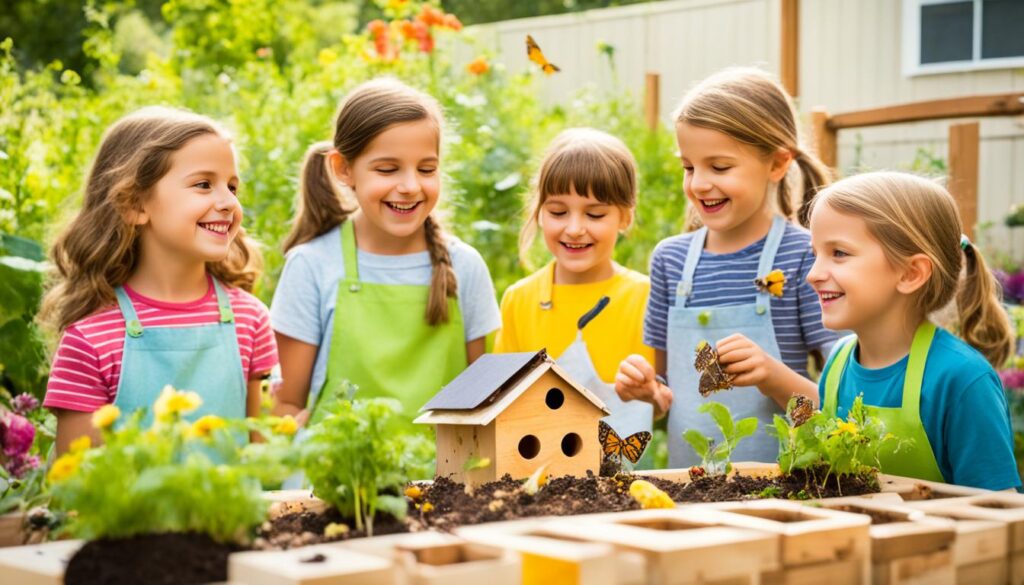
- Paint and plant recycled tin cans as colorful herb containers
- Create mini greenhouses from plastic bottles for seed starting
- Build a worm farm to observe decomposition and soil enrichment
- Design a butterfly garden with native flowering plants
These activities teach kids about plant cycles, composting, and pollinators. They learn patience, responsibility, and feel proud as they watch their garden grow.
| Project | Materials Needed | Learning Outcome |
|---|---|---|
| Tin Can Planters | Empty cans, paint, soil, seeds | Recycling, plant care |
| Bottle Greenhouse | Plastic bottles, scissors, soil, seeds | Seed germination, microclimate |
| Worm Farm | Plastic bin, soil, food scraps, worms | Decomposition, soil health |
| Butterfly Garden | Native plants, garden tools, mulch | Pollination, ecosystem balance |
By mixing sustainable garden crafts with educational gardening, you make a great learning space. It helps both plants and young minds grow. These experiences build a deep love for nature and sustainable living.
Greenhouse and Plant Propagation
More people are using energy-efficient greenhouses and sustainable plant breeding to grow plants longer and grow more varieties. These methods help the environment and save money over time.
Energy-efficient greenhouses use natural light and heat, cutting down on artificial sources. You can make your greenhouse better with insulation, thermal mass materials, and smart window placement for air flow. Some gardeners use solar panels to power their greenhouses.
Sustainable plant breeding is also key for eco-friendly gardening. Learning how to propagate plants lets you use fewer store-bought plants and keep plant diversity. Here are some ways to do it:
- Taking cuttings from healthy plants
- Layering branches to encourage root growth
- Dividing mature plants into smaller sections
These methods help you make new plants from ones you already have. It saves money and keeps your favorite plants going. Plus, you get to watch plants grow from the start.
“Sustainable gardening is not just about growing plants; it’s about fostering a connection with nature and preserving biodiversity for future generations.”
Using energy-efficient greenhouses and sustainable plant breeding makes your garden better for the planet. It also teaches you skills that help in your gardening.
Herbal and Pollinator Gardening
Turn your garden into a home for pollinators and a place full of medicinal plants. By making bee-friendly gardens, you help a healthy ecosystem grow. You also get to enjoy nature’s pharmacy.
Begin by picking herbs known for their healing powers. Lavender, chamomile, and echinacea are great options. These plants help you and attract good insects to your garden.
“A garden is a grand teacher. It teaches patience and careful watchfulness; it teaches industry and thrift; above all it teaches entire trust.”
To make your garden bee-friendly, add plants that bloom all year. Early spring flowers like crocus and hyacinth feed the first pollinators. Summer plants such as coneflowers and black-eyed Susans keep the food coming. Autumn asters and goldenrod offer a last meal before winter.
Plant in groups to help pollinators find food easily. Make sure there’s shallow water around and don’t use harmful pesticides. This keeps the garden safe for these important creatures.
By mixing medicinal plants with those that attract pollinators, you make a garden that helps the local ecosystem. It also gives you natural remedies right in your yard. Enjoy the beauty and benefits of herbal and pollinator gardening for a lively, varied garden.
Sustainable Harvesting and Climate Resilience
Practicing responsible foraging and climate-adaptive gardening makes your garden sustainable and resilient. These methods help your garden survive and adapt to weather changes.

To forage responsibly, take only what you need. This lets wildlife and plants regrow. It keeps your garden’s ecosystem balanced and plants healthy for the long term.
For climate-adaptive gardening, pick plants that can handle extreme weather. Choose drought-tolerant plants like lavender, rosemary, and succulents. They need less water and can survive dry spells.
- Install rainwater collection systems
- Use mulch to retain soil moisture
- Create windbreaks with sturdy shrubs or trees
- Implement shade structures for heat-sensitive plants
Using these strategies, you’ll create a garden that’s productive and resilient to climate changes. Sustainable harvesting and climate-adaptive gardening work together. They make sure your garden does well for years.
“A garden is a grand teacher. It teaches patience and careful watchfulness; it teaches industry and thrift; above all it teaches entire trust.”
Adopt these sustainable practices and see your garden thrive, even with environmental challenges. Your efforts in responsible foraging and climate-adaptive gardening help create a healthier, more resilient ecosystem.
Mulching, Community Gardening, and Livestock Integration
Using sustainable gardening practices can make your outdoor space a thriving ecosystem. Organic mulch is a key technique for a healthy garden. It helps by saving water, controlling weeds, and making the soil richer.
Collaborative gardening lets you share resources and knowledge with others. Work with neighbors to make a garden that everyone can enjoy. You’ll get to swap tips and produce, and make strong bonds with people nearby.
Adding small animals like chickens or rabbits to your garden makes it even more sustainable. They help control pests and make the soil better. Here’s how these elements work together:
- Organic mulch keeps the soil moist and improves its structure
- Community gardens are great for sharing and learning
- Small animals help with pest control and make the soil richer
By mixing these methods, you’ll have a garden that’s diverse and strong. Use organic mulch, work together with others, and keep small animals to make a sustainable garden. This way, you’ll have a green oasis in your backyard or community area.
Permaculture Guilds and Sustainable Structures
Discover the magic of plant communities in your garden. Permaculture guilds create balanced ecosystems where plants work together. These guilds mimic nature’s wisdom, bringing harmony to your green space.
Imagine a guild with fruit trees at its center. Add nitrogen-fixing plants, beneficial insects, and ground cover around them. This setup helps soil health and boosts productivity. Your garden becomes a thriving ecosystem, supporting diverse life forms.
Eco-friendly garden buildings take sustainability to new heights. Green roofs turn barren surfaces into lush areas. They absorb rainwater, cut energy costs, and create wildlife habitats. Living walls bring vertical gardens to life, making plain walls vibrant and air-purifying.
“Permaculture is revolution disguised as gardening.” – Graham Bell
Recycled materials get a new life in raised beds. Old tires, wooden pallets, or concrete blocks become homes for thriving plants. These upcycled structures add character to your garden while reducing waste.
Embrace these sustainable practices. Watch your garden flourish as a testament to nature’s ingenuity and your eco-conscious choices. Your green space will inspire others, spreading the joy of sustainable gardening far and wide.
Seasonal Crop Guides and Organic Certification
Planting calendars are key for gardeners who care for the planet. They help you plan your garden all year, making sure you plant at the best times. This way, you get a bigger harvest and use less resources.
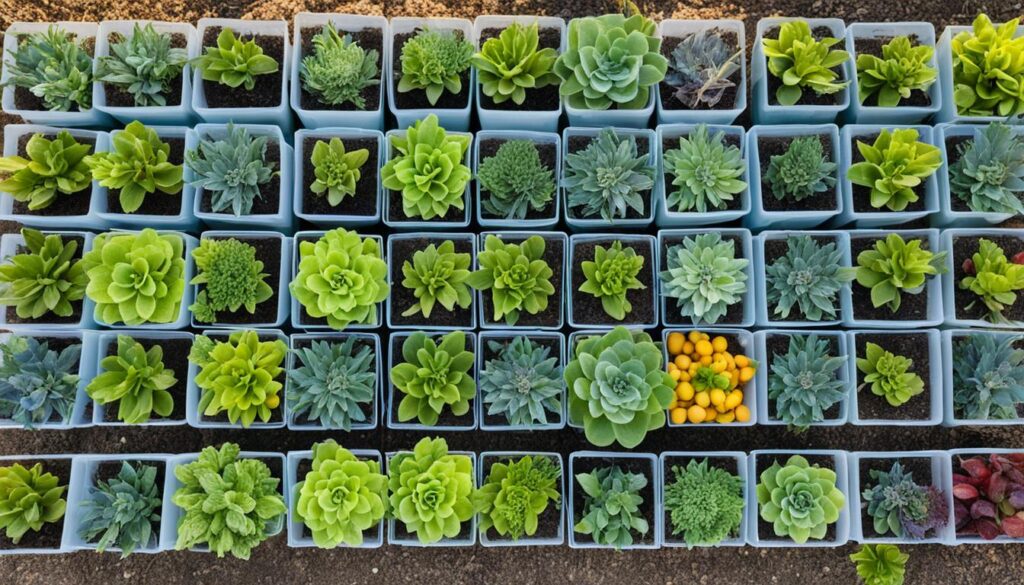
It’s easy to make your own planting calendar. First, learn about your local climate and when the frost hits. Then, pick the veggies you want to grow and when they do best. Put this info into a chart or table for quick checks.
| Season | Crops to Plant | Harvest Time |
|---|---|---|
| Spring | Lettuce, Peas, Radishes | Early Summer |
| Summer | Tomatoes, Peppers, Cucumbers | Late Summer/Early Fall |
| Fall | Kale, Carrots, Beets | Winter |
| Winter | Garlic, Cover Crops | Following Year |
If you want to go further in sustainable gardening, consider organic garden certification. This means following strict rules set by groups that check your garden. You’ll need to use organic seeds, skip synthetic stuff, and keep detailed records of your work.
Getting certified takes time and money, but it has perks. Your produce could be worth more, and people will know you care about the planet. Even without certification, using organic ways in your garden helps the environment and gives your family healthier food.
Technology and Mental Health Benefits
Step into the future of gardening with smart tools that make it easy to care for your garden. Solar-powered trimmers and robotic mowers help the planet while keeping your lawn looking great. Smart irrigation systems use weather data to water your plants just right, saving water.
Gardening is more than just good for your body. It’s a way to boost your mental health, offering a break from stress. As you work with your plants, your worries will fade away, leaving you feeling calm and fulfilled.
“Gardening is the purest of human pleasures.”
There are many benefits to sustainable gardening that go beyond your garden:
- Stress reduction through connection with nature
- Increased physical activity without feeling like exercise
- Improved mood and sense of accomplishment
- Enhanced cognitive function and creativity
By using eco-friendly tech in gardening, you create a space that helps your mental and environmental health. Let your garden be a place of peace, growth, and new beginnings.
| Smart Garden Tool | Benefit |
|---|---|
| Solar-powered trimmer | Reduces carbon emissions |
| Smart irrigation system | Conserves water |
| Plant sensors | Optimizes plant care |
| Robotic mower | Saves time and energy |
Conclusion
Sustainable gardening is more than a trend; it’s key to taking care of our planet. By using eco-friendly methods, you help your garden grow and protect the Earth. Techniques like composting and saving rainwater are important for a smaller footprint.
Planting native plants and making your garden friendly for wildlife helps local nature. This supports bees and other helpful animals, making your garden a balanced place. Using sustainable gardening tips means you’re helping the planet.
Every little change helps. Rotating crops, using natural pest control, or reusing materials makes a big difference. Your garden shows others that beauty and caring for the Earth can go together. By doing this, you’re helping create a better future for everyone.
FAQ
What is sustainable gardening?
Sustainable gardening combines organic methods with saving resources. It aims to help the planet by supporting ecosystems and using less resources. It includes natural pest control, saving water, composting, and easy-to-maintain designs.
Why is soil health important in sustainable gardening?
Soil health is key for sustainable gardening. Avoid synthetic fertilizers that harm the planet. Use homemade compost from garden and household waste for organic fertilizer. Consider coir-based compost over peat-based products to protect natural peat bogs.
How can I conserve water in my sustainable garden?
Save water by collecting rain in barrels and using greywater for plants. Use soaker hoses or drip systems. Mulch helps keep soil moist and cuts down on evaporation. Water plants in the early morning or at night to save water.
What are some organic pest control methods?
Use organic pest control instead of chemicals. Try crop rotation, soil care, and physical barriers. Use biological controls like attracting helpful insects. For pests, use neem oil or food-grade diatomaceous earth.
What is companion planting, and how does it benefit sustainable gardening?
Companion planting means placing plants together for mutual benefits. It can keep pests away, help with pollination, and make plants grow better. Find and use compatible plants to cut down on chemicals and support a balanced garden.
How can I incorporate permaculture principles into my sustainable garden?
Permaculture focuses on nature, energy, yield, self-regulation, renewable resources, and waste-free production. It aims to create ecosystems that work like nature. This approach helps make gardens self-sustaining.
How can I create a wildlife-friendly sustainable garden?
Make your garden a home for wildlife by offering food, water, and shelter. Use natural fertilizers like compost, bone meal, or seaweed. These improve soil health without harming wildlife or polluting water.
Why should I practice seed saving in my sustainable garden?
Saving seeds preserves plant diversity and cuts down on buying seeds. It lets you pick seeds that work best in your area.
What are some sustainable gardening techniques for urban environments?
Use container gardens, rooftop gardens, or community plots in cities. Plan for year-round harvests with a mix of crops and techniques like cold frames or polytunnels.
How can I incorporate native plants into my sustainable garden?
Use native plants to support local ecosystems and save on garden work. They fit your climate well and need less water and care.
Seasonal Guide to Companion Planting
Unlock the secrets to a thriving garden all year with our guide to companion planting. But what is companion planting, and how does it help your garden? Learn about strategic plant pairings to make your garden better.
Key Takeaways
- Companion planting is the practice of growing different plants together for mutual benefit.
- Discover the advantages of companion planting, from pest control to increased yields.
- Explore seasonal companion plant pairings for your garden, from spring to winter.
- Learn how to plan a companion planting garden for maximum effectiveness.
- Attract beneficial insects and deter pests with the right companion plants.
Understanding Companion Planting
Companion planting is a way to grow plants together to help each other. It’s an old method that says plants can help each other out. By doing this, each plant gets something good from the others in the companion planting basics.
What is Companion Planting?
It’s about making a garden where different plants live together well. By choosing the right plants to grow side by side, gardeners can make their gardens healthier and more productive. This means picking plants that attract good bugs, keep pests away, or make the soil better.
Benefits of Companion Planting
The benefits of companion planting are many and can change how you garden. Some main advantages are:
- Less pest damage from natural pest control
- Better soil nutrition and fertility
- More pollination and higher yields
- Smart use of garden space
- Beautiful and varied plantings
Learning about companion planting helps you make a garden that works well with nature.
“Companion planting is a time-honored gardening technique that allows plants to work together, resulting in a more productive and beautiful garden.”
Planning a Companion Planting Garden
When planning a garden, picking the right plants is key. Some plants help each other grow, while others can harm each other. It’s important to choose plants that work well together.
Choosing Compatible Plants
Look for plants that grow well together. Tomatoes and basil are great together because basil keeps pests away from tomatoes. Marigolds also help by fighting off pests in the soil.
Considering Plant Growth Habits
Think about how tall and big plants will get. Taller plants can shade smaller ones that need sunlight. Vines can climb up trellises, saving space in your garden.
| Plant | Companion Plants | Incompatible Plants |
|---|---|---|
| Tomatoes | Basil, Marigolds, Chives | Potatoes, Fennel, Dill |
| Carrots | Radishes, Chives, Rosemary | Dill, Parsnips |
| Lettuce | Carrots, Radishes, Cucumbers | Broccoli, Cauliflower |
Planning carefully will help you create a garden that works well together. This way, you get the most out of companion planting.
Spring Companion Planting
As the weather gets warmer and the earth awakens, it’s a great time to dive into spring companion planting. By thoughtfully pairing vegetables, herbs, and flowers, you can make a garden that flourishes all spring long.
Spring Vegetable Companions
When setting up your spring vegetable garden, think about which plants work well together. Asparagus and basil or marigolds can keep pests away and draw in good bugs. Broccoli and cabbage do well with nasturtiums, which lure aphids away. Carrots are happy with rosemary or sage, which keep carrot flies at bay.
Spring Flower Companions
Adding spring flowers to your garden can really boost the ecosystem. Flowers like borage, dill, and poached egg plants attract bees and butterflies, which are key for your garden’s success. These flowers also bring in beneficial bugs, like ladybugs and lacewings, that eat garden pests.
| Spring Vegetable | Companion Plants | Benefits |
|---|---|---|
| Asparagus | Basil, Marigolds | Pest deterrence, Beneficial insect attraction |
| Broccoli, Cabbage | Nasturtiums | Trap cropping, Pest deterrence |
| Carrots | Rosemary, Sage | Pest deterrence |
Choosing the right spring companion plants helps your garden grow well and look great. Enjoy the season’s abundance with a well-thought-out spring planting plan.
Summer Companion Planting
As summer comes, companion planting opens up new ways to make your garden better. It brings special pairings and strategies for the summer season. These can boost your garden’s productivity and beauty.
Summer is a great time to use plants that give shade and support to others. For example, tall corn plants can shade lettuce from the hot sun. Vines like cucumbers can grow up pole beans, helping each other out and saving space.
Summer is perfect for adding flowers that keep pests away and attract pollinators. Flowers like sunflowers, zinnias, and cosmos brighten up your garden. They also keep pests away and draw in helpful insects for your crops.
| Companion Plant | Benefit |
|---|---|
| Corn | Provides shade for lettuce and other leafy greens |
| Cucumbers | Climbs and intertwines with pole beans, providing mutual support |
| Sunflowers | Deter pests and attract pollinators |
| Zinnias | Deter pests and add vibrant color to the garden |
| Cosmos | Attract beneficial insects and pollinators |
By carefully choosing your summer plants and using companion planting, you can make a garden that’s full of life. It will be good for your plants and the environment too.
Fall Companion Planting
As summer ends and autumn arrives, the garden changes. It starts to focus on plants that do well in cooler weather and less sunlight. By choosing the right plants together, gardeners can make their gardens last longer, keep pests away, and make it look beautiful.
Fall Vegetable Companions
With the days getting shorter, vegetables like kale, brussels sprouts, and root crops shine. These plants do great in the cool. Adding garlic or sage near them keeps pests away. Radishes help by aerating the soil and drawing pests away from the main plants.
Fall Flower Companions
Flowers like chrysanthemums, asters, and marigolds are perfect for fall. They add color to the garden and attract helpful insects. These insects keep pests away. Adding these flowers to your garden keeps it healthy and full of life even in the cooler months.
| Fall Vegetable Companions | Fall Flower Companions |
|---|---|
|
|
Fall companion planting lets gardeners have a garden that’s full of life and looks great. It’s easy to take care of and keeps going even after summer ends.
Winter Companion Planting
When winter comes, companion planting is still key for your garden. By picking the right plants together, you can make a winter garden that thrives, even in tough conditions.
Winter Vegetable Companions
Winter companion planting helps protect delicate crops. Pair cold-hardy greens like spinach and kale with taller plants that block wind and frost. Onions and herbs like rosemary and thyme are great for winter, adding strength to your garden.
- Spinach: Pair with taller, bushy plants for wind and frost protection
- Onions: Provide a sturdy base for winter vegetable companions
- Rosemary and thyme: Hardy herbs that can withstand winter conditions
Arranging your winter plants wisely makes your garden stronger and more productive, even when it’s cold. Use companion planting to overcome winter gardening challenges and enjoy a rich harvest.
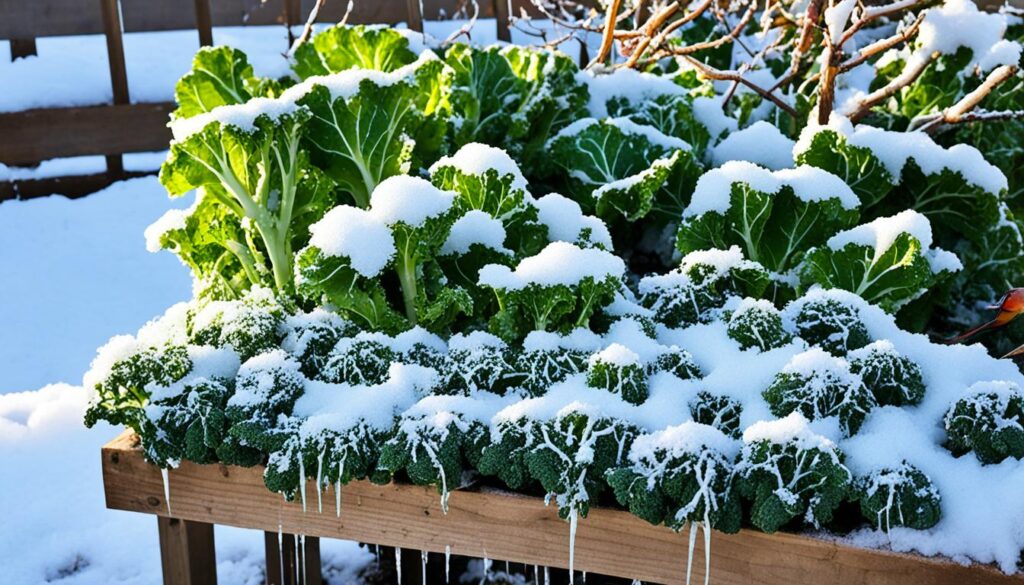
“Companion planting is a fantastic way to maximize the potential of your winter garden, even in the face of challenging conditions.”
Popular Companion Planting Combinations
Companion planting is a gardening method that pairs plants together for mutual benefits. Tomatoes and basil, and the “Three Sisters” of corn, beans, and squash, are top choices. These combinations help each plant grow better.
Tomato and Basil
Tomatoes and basil are a classic pair in gardening. Basil keeps pests away from tomatoes and makes them taste better. This duo is perfect for gardeners.
The Three Sisters: Corn, Beans, and Squash
The Three Sisters method has been used by Native American tribes for years. Corn, beans, and squash help each other out in many ways. Corn stalks support beans, and squash leaves keep weeds down and soil moist.
| Crop | Benefit |
|---|---|
| Corn | Provides structure for beans to climb |
| Beans | Fix nitrogen in the soil, improving corn and squash growth |
| Squash | Shades the soil, preventing weed growth and retaining moisture |
These combinations show how planting certain plants together can make a garden better. It’s all about creating a balanced garden ecosystem.
“Companion planting is a gardening technique that pairs certain plants together to create mutually beneficial relationships.”
Seasonal Companion Planting Guide
Crafting a thriving garden is all about understanding how plants work together. Seasonal companion planting lets you use these natural partnerships to boost growth, control pests, and increase productivity all year.
Whether you’re starting with spring veggies, summer flowers, or fall harvests, this guide will show you the best plant friends for each season. By choosing plants that grow well together, you can make a garden that fights pests and diseases. It will also draw in helpful insects.
Spring Companion Planting
In spring, pair leafy greens with radishes or carrots. These strong-smelling veggies keep pests away from your spring greens. Also, marigolds near tomato plants can fend off harmful insects and nematodes.
Summer Companion Planting
With the heat up, team peppers and eggplants with basil or borage. These friends not only taste better together but also bring in helpful pollinators to your garden.
Fall Companion Planting
When it gets cooler in fall, pair brassicas like kale and broccoli with aromatic herbs such as rosemary and thyme. These teams keep pests away and boost your fall crops’ health.
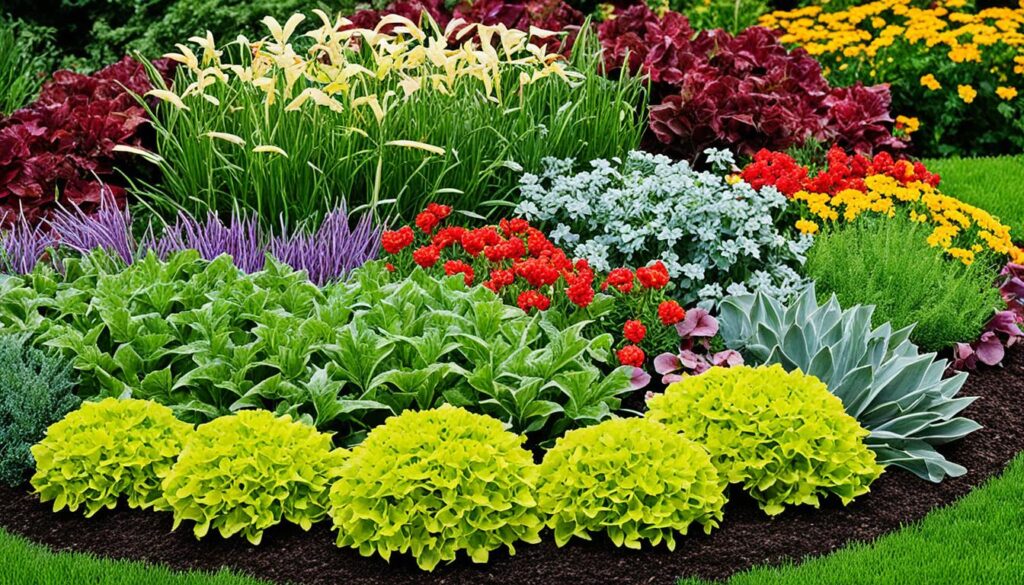
Using this seasonal companion planting guide, you can make a garden that thrives all year. Smart plant pairings boost growth, attract good bugs, and keep pests away.
Attracting Beneficial Insects
Companion planting is a great way to draw beneficial insects like pollinators and pest predators to your garden. By adding flowers full of nectar, you can attract bees, butterflies, and hoverflies. These insects will help pollinate your plants and eat pests.
Flowering Plants for Pollinators
Zinnias, cosmos, and sunflowers are great flowers that are full of nectar. They make your garden more diverse and healthy. These plants bring in many beneficial insects, including:
- Bees – essential for pollinating many fruits and vegetables
- Butterflies – add a touch of beauty while also pollinating flowers
- Hoverflies – feed on aphids and other garden pests
Adding flowering plants for pollinators to your garden makes it healthier and less dependent on chemicals. It also means you’ll need fewer pesticides. By attracting beneficial insects, your plants will do better and you’ll help the environment.
| Flowering Plant | Beneficial Insects Attracted | Garden Benefits |
|---|---|---|
| Zinnia | Bees, Butterflies, Hoverflies | Pollination, Pest Control |
| Cosmos | Bees, Butterflies, Ladybugs | Pollination, Pest Control |
| Sunflower | Bees, Butterflies, Lacewings | Pollination, Pest Control |
By using flowering plants for pollinators in your garden, you can attract beneficial insects. This makes your garden a healthy, balanced place.
Deterring Pests with Companion Plants
Companion planting is great for keeping pests away from your garden. By pairing plants that naturally keep pests away, you can make your garden healthier. Plants like garlic, mint, and marigolds keep insects away without harsh chemicals.
These plants also attract beneficial insects and help your plants grow strong. Adding them to your garden is a smart way to fight pests naturally. It makes your garden safe for you and the environment.
Using companion plants is good for all types of gardens. It’s a green way to keep pests away from your plants. With a little planning, your garden will be beautiful and pest-free, supporting a healthy environment.
FAQ
What is companion planting?
Companion planting means growing different plants together for their mutual benefits. This practice offers clear advantages to each plant.
What are the benefits of companion planting?
It helps reduce pests, improve soil health, and fight weeds. It also boosts crop yields and makes gardens look better.
How do I choose compatible plants for companion planting?
Pick plants that work well together, considering their growth patterns. Some plants help each other, while others can harm each other’s growth.
What are some good spring companion plants?
Great spring plants include basil, marigolds, and nasturtiums. For flowers, choose ones like borage, dill, and poached egg plants to attract pollinators and pests.
What about summer companion plants?
In summer, use flowers like sunflowers, zinnias, and cosmos to keep pests away and attract pollinators. For veggies, pair them to provide shade or support each other.
What are good fall companion plants?
Good fall plants are garlic, sage, and radishes. For flowers, pick late bloomers like chrysanthemums, asters, and marigolds to draw in beneficial insects.
What about winter companion planting?
In winter, focus on veggies that protect each other from the cold. Pair cold-hardy greens with taller plants. Good winter friends include spinach, onions, and herbs like rosemary and thyme.
What are some popular and effective companion planting combinations?
Top combos include tomatoes with basil and the “Three Sisters” of corn, beans, and squash.
How can companion planting help attract beneficial insects?
Plants like zinnias, cosmos, and sunflowers attract bees, butterflies, and hoverflies. These insects pollinate your crops and eat garden pests.
How can companion planting help deter pests?
Herbs like garlic, mint, and marigolds keep insects away. Flowers such as nasturtiums distract pests from your crops.
Source Links
Improving Soil Health with Companion Planting
Are you tired of dealing with poor soil in your garden? Wondering if there’s a natural way to make your soil better? Look into companion planting. By pairing certain plants together, you can make your soil richer and healthier. This creates a thriving garden ecosystem.
This article will show you how companion planting can improve soil health. It helps with fertility, keeps nutrients balanced, and supports good microbes. It also cuts down on the need for harmful chemicals. Get ready to see how this gardening trick can change your garden!
Key Takeaways
- Companion planting can significantly enhance soil fertility and nutrient balance.
- Strategic plant pairings can create a more diverse and resilient soil ecosystem.
- Certain companion plants can help suppress pests and diseases, reducing the need for chemical interventions.
- Integrating cover crops and green manures into your companion planting system can further improve soil health.
- Companion planting can also help your plants become more drought-resistant and better able to withstand challenging environmental conditions.
The Benefits of Companion Planting
Companion planting is great for making soil healthier and more fertile. By pairing soil-enriching plants and nutrient-boosting plants, you make a garden that helps each plant grow better. This method makes your garden more vibrant and healthy.
Enhancing Soil Fertility
Having different roots in your garden is key to better soil. Plants like broccoli and cabbage grow close to the surface. They work well with tomatoes, which have deeper roots. This way, they get different nutrients from the soil.
Adding plants like peas, beans, and clover can also help. These plants fix nitrogen in the soil. When they break down, they give back nitrogen to the soil. This cuts down on the need for chemical fertilizers.
Maintaining Nutrient Balance
Companion planting keeps the soil balanced and healthy. By growing many different plants, you make your garden strong against nutrient shortages. This keeps the soil rich and supports many types of crops.
“Companion planting is a powerful tool for gardeners and farmers alike, as it allows them to harness the natural synergies between plants to improve soil health and fertility.”
Companion planting is a big win for soil health. By choosing the right soil-enriching plants and nutrient-boosting plants, you create a garden that feeds itself. This leads to a garden full of diverse and healthy plants.
Understanding Companion Planting Arrangements
Successful companion planting means knowing how different plants work together and with their environment. Things like plant height, growth patterns, and how they fight pests or diseases are key. By picking and placing your plants right, you can make a garden that’s healthier and more productive.
When looking at companion planting arrangements, keep these main points in mind:
- Compatibility: Choose plants that grow well together, need similar nutrients, and resist pests and diseases.
- Companion planting techniques like intercropping, succession planting, and polycultures help use space better and increase diversity.
- Plan your companion planting patterns to make the most of light, water, and nutrients for all plants.
| Companion Plant | Beneficial Attributes | Ideal Companions |
|---|---|---|
| Marigolds | Repels nematodes, attracts beneficial insects | Tomatoes, peppers, eggplants |
| Nasturtiums | Trap crops for aphids, adds nutrients to soil | Cucumbers, radishes, cabbage |
| Chamomile | Improves soil health, deters pests | Onions, carrots, brassicas |
Learning about companion planting arrangements helps you make a garden that fights pests, diseases, and stress better.
“Companion planting is not just about which plants grow well together, but how they can support each other’s growth and health.”
Intercropping: Maximizing Space and Diversity
Intercropping means growing different crops together in one spot. It’s great for gardeners and small farmers. By mixing early and late crops, you can maximize your garden space and boost diversity. This method makes your garden look better and helps your plants grow healthier and more productive.
Planting Patterns and Techniques
Choosing the right companion planting patterns and techniques is key. For instance, grow quick-growing crops like lettuce or spinach with slower ones like peppers or tomatoes. This way, you use your space well.
Intercropping lets you use the unique growth and needs of different plants. It makes your garden stronger and more productive. You get better pest and disease control, richer soil, and a balanced nutrient cycle.
“Intercropping is a sustainable and efficient way to grow a diversity of crops in a limited space, while also supporting the overall health of your garden ecosystem.”
To make the most of intercropping, try out different patterns and techniques. Watch how your plants do together and adjust as needed. With creativity and care, you can enjoy the benefits of intercropping and turn your garden into a lush, diverse place.
Amending Soils with Companion Planting
Improving soil health is easy with companion planting. By picking the right plants together, you can fix nutrient gaps and make your soil richer. This method uses amending soil with companion plants to boost your garden’s health.
Adding nutrient-boosting plants to your garden helps refill the soil with what it needs. Legumes like peas or beans add nitrogen. Plants with deep roots, such as comfrey or dandelions, bring up minerals from deep down.
- Increase mulch around plant bases to retain moisture and improve soil structure
- Add earthworms to aerate compacted soils and enhance nutrient cycling
- Integrate cover crops to help replenish depleted soil nutrients and improve overall soil health
By choosing the right soil amendment techniques, your garden can become a place of growth and health. Watch your soil and pick the best companion plants to fill any gaps. This way, your garden will be full of life and productivity.
“Companion planting is a powerful tool for improving soil health and creating a more sustainable, self-regulating garden ecosystem.”
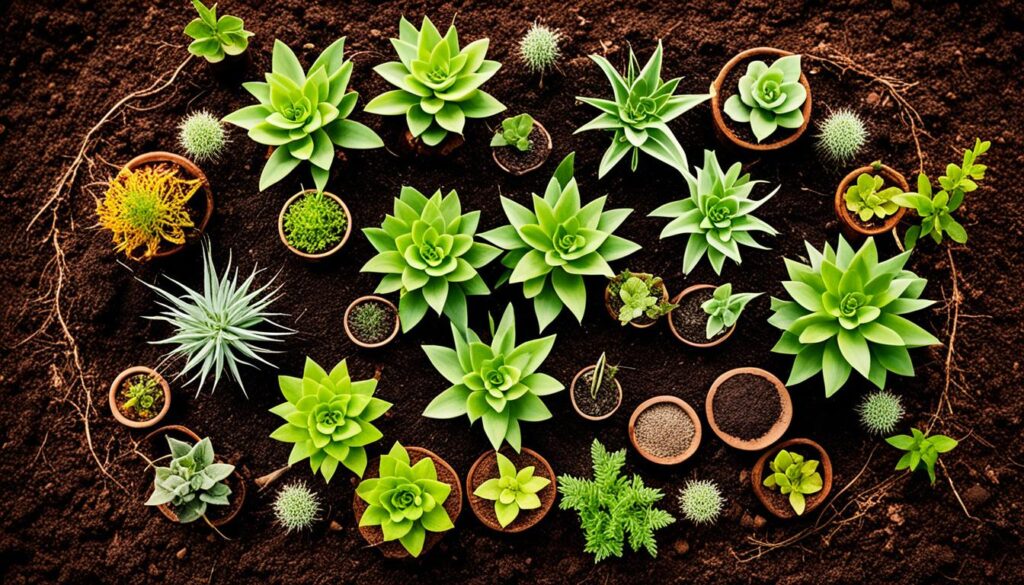
improving soil health with companion planting
Using companion planting can make your soil healthier and more lively. It creates a diverse garden that boosts soil fertility and keeps nutrients balanced. This helps plants grow better, fight off pests, and makes your garden more sustainable.
Companion planting for soil health lets you add soil-enriching plants to your garden. These plants fix nitrogen, gather minerals, or release compounds that help other plants and soil life.
- Nitrogen-fixing plants, like beans, add more nitrogen to the soil. This cuts down on the need for synthetic fertilizers.
- Plants that improve soil by gathering minerals keep the soil balanced. This makes sure plants get what they need to grow well.
- Root exudates and healthy microbes from plants make the soil better for plant growth.
Choosing and arranging your companion planting wisely helps plants work together. This approach makes your garden healthier and more productive. It also makes the soil better and creates a strong, diverse garden ecosystem.
“Companion planting is a powerful tool for building healthy, living soil that supports vibrant, resilient plant life.”
Adding companion planting for soil health is good for the planet and your garden. It uses plant synergies to create a system that needs less outside help. This keeps your soil fertile and productive for a long time.
The Role of Root Exudates and Soil Microbes
Companion planting changes the soil microbiome in big ways, thanks to root exudates. These are compounds released by plant roots that help beneficial soil microbes grow. By knowing how root exudates and soil microbes work together, gardeners and farmers can create a healthy soil community. This supports soil health and keeps the ecosystem balanced.
Promoting Beneficial Microbial Communities
Some plants release compounds through their roots that help beneficial microorganisms grow. These microbes are key in nutrient cycling, fighting off diseases, and making soil fertile. By choosing the right plant partners, gardeners can build a strong soil microbiome. This helps crops stay healthy and productive.
- Certain root exudates boost nitrogen-fixing bacteria, making more nutrients available.
- Other exudates stop soil-borne pathogens, lowering the chance of plant diseases.
- A diverse community of beneficial soil microbes improves soil structure, water retention, and nutrient cycling.
Using companion planting, gardeners and farmers can create a lively soil microbiome. This supports the health and strength of their plants.
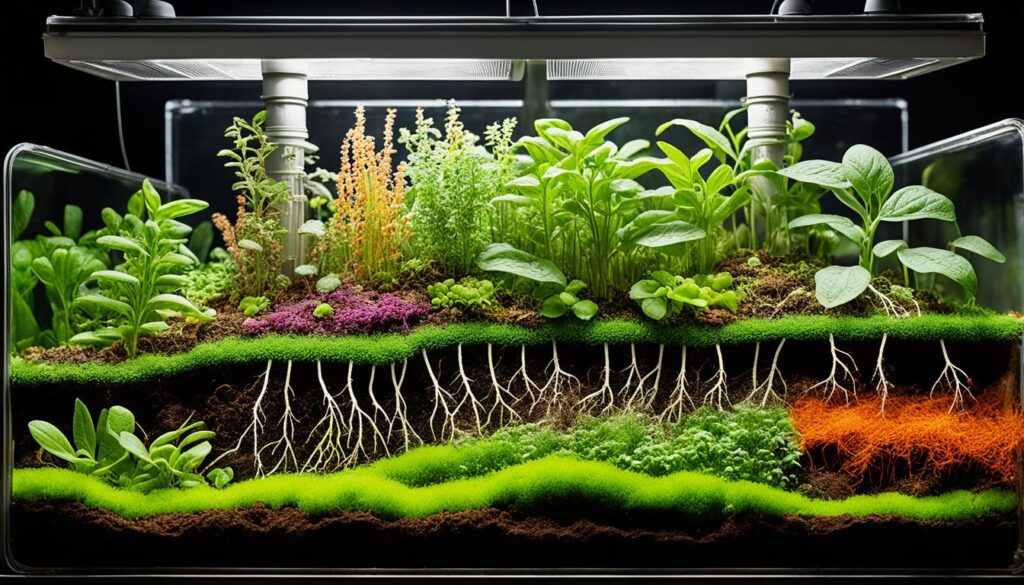
“The soil microbiome is the foundation of a healthy, productive ecosystem. By understanding the role of root exudates, we can unlock the true potential of companion planting to foster a diverse and beneficial microbial community.”
Pest and Disease Management through Companions
Companion planting is a great way to control pests and diseases naturally in your garden. By placing different plants together, you make your garden less welcoming to pests. This means you use fewer chemicals and your garden stays healthier.
Some plants smell bad to pests, keeping them away from your crops. Others hide the look of your plants from pests. And, some plants bring in good bugs like ladybugs that eat the bad bugs.
- Companion planting for pest control can help reduce the reliance on synthetic pesticides.
- Companion plants can emit odors or visually camouflage target crops, making them less appealing to pests.
- Certain companion species can attract beneficial insects that prey on common garden pests.
By mixing different plants together, you make a garden that fights pests and diseases on its own. This method cuts down on harmful chemicals. It also helps your plants and local wildlife thrive together.
| Companion Plant | Pest or Disease Targeted | Mechanism of Action |
|---|---|---|
| Marigolds | Nematodes, aphids, and other garden pests | Marigolds release a compound called thiopene, which acts as a natural pest repellent. |
| Nasturtiums | Aphids, whiteflies, and other sucking insects | Nasturtiums produce a strong scent that can confuse and deter many garden pests. |
| Basil | Tomato hornworms and mosquitoes | Basil’s fragrant leaves can repel tomato hornworms, and the plant’s essential oils also act as a natural mosquito deterrent. |
Using these companion plants for disease resistance helps your garden fight pests naturally. This method is better for your plants and the environment. It makes your garden healthier and more sustainable.
Nutrient Cycling and Soil Enzyme Activities
Companion planting greatly affects nutrient cycling and soil enzyme activities. These are key to soil health. The roots and chemicals from different plants help soil enzymes break down organic matter and release nutrients.
The Impact of Companion Plants
This boosts soil fertility and plant growth. By knowing how nutrient cycling in companion planting, soil enzyme activities, and how companion plants impact soil work together, gardeners can improve their crops. This leads to better productivity and sustainability.
| Nutrient Cycling Indicator | Impact of Companion Plants |
|---|---|
| Soil Enzyme Activity | Increased activity of enzymes involved in organic matter decomposition and nutrient mobilization |
| Nitrogen Cycling | Improved nitrogen fixation and availability through legume companions |
| Phosphorus Cycling | Enhanced solubilization and uptake of inorganic phosphorus |
| Potassium Cycling | Improved mobilization and recycling of potassium from mineral sources |
By using nutrient cycling in companion planting, gardeners and farmers can make their soil better. This leads to healthier plants and more food.
Companion Planting for Drought Resistance
Gardening in dry areas requires plants that can handle drought well. Companion planting is a great way to make gardens more resilient. Some plants have deep roots that help keep soil moist for others.
Companion planting also improves soil health. As different plants grow together, their roots mix and break down, making soil better at holding water. This means your garden can survive with less water.
| Drought-Resistant Companion Plants | Characteristics |
|---|---|
| Lavender (Lavandula spp.) | Deep, drought-tolerant roots that can help improve soil moisture retention |
| Rosemary (Rosmarinus officinalis) | Aromatic herb with a robust root system, thriving in dry conditions |
| Yarrow (Achillea millefolium) | Extensive root system that can help distribute water to neighboring plants |
Adding these drought-resistant plants to your garden makes your plants stronger and helps your soil hold moisture better. A well-planned garden can handle changing weather and water issues well.
Integrating Cover Crops and Green Manures
Improving soil health and nutrient cycling is key for sustainable farming. Using cover crops and green manures can change the game. Cover crops like legumes, grasses, and brassicas help fix nitrogen, fight weeds, and add organic matter to the soil. Green manures, from decomposed plants or compost, boost nutrients and help beneficial soil microbes.
Choosing the right cover crops for your climate and soil is crucial. Legumes, such as clover and alfalfa, take nitrogen from the air for your crops. Grasses, like rye and oats, build soil matter and stop erosion. Brassicas, including mustard and radish, break up hard soil and release nutrients as they decay.
- Try different cover crop mixes to see what works best for you.
- Plan when to plant and add cover crops with your main crops’ needs.
- Use cover crops and green manures together for a nutrient cycle boost.
Adding cover crops and green manures to your planting can unlock your soil’s full potential. It creates a thriving ecosystem that helps your plants grow. This simple method improves soil health and keeps your land productive for years.
| Cover Crop | Benefit |
|---|---|
| Legumes (e.g., clover, alfalfa) | Nitrogen fixation, improve soil fertility |
| Grasses (e.g., rye, oats) | Increase organic matter, prevent soil erosion |
| Brassicas (e.g., mustard, radish) | Break up compacted soil, release nutrients |
“Integrating cover crops and green manures into your companion planting system is a powerful way to enhance soil health and nutrient cycling, ensuring the long-term productivity of your land.”
Conclusion
Companion planting is a great way to make your garden better. By choosing the right plants together, you can make the soil richer and keep it balanced. This method also helps create a garden that is strong and diverse.
It helps with nutrient cycling and fights pests and diseases naturally. This makes it a green and complete way for gardeners to improve their soil and grow a healthy garden.
Adding companion planting to your garden can make it more productive and good for the planet. It makes the soil better, which means your plants will be healthier and taste better. It also helps the good bugs and cuts down on harm to the environment.
If you’re new to gardening or have been doing it for years, trying companion planting can be exciting. It opens up new ways to garden sustainably and makes your garden more lively and full of life.
Using companion planting lets you make the most of your garden. It creates a balanced and self-supporting garden that’s good for you and the earth. Start using companion planting to make your gardening better and greener.
FAQ
What are the benefits of companion planting for soil health?
Companion planting boosts soil fertility and keeps nutrients balanced. It makes your garden more diverse and resilient. It also helps with soil aeration, nutrient uptake, and beneficial microorganisms.
How does companion planting help with nutrient cycling and soil enzyme activities?
Some plants boost soil enzymes that break down organic matter and release nutrients. This makes nutrient cycling better and helps soil fertility and productivity.
Can companion planting help manage pests and diseases naturally?
Yes, it can be a natural way to fight pests and diseases. Some plants release smells or attract insects that keep pests away. Others hide the signs that pests use to find plants.
How can companion planting improve a garden’s resilience to drought conditions?
Some plants have deep roots that help spread and hold moisture in the soil, helping other plants. Also, more soil organic matter and better soil structure from companion planting help soil hold water better. This lessens the effect of drought on your plants.
How can cover crops and green manures be integrated into a companion planting system?
Use cover crops like legumes, grasses, and brassicas to fix nitrogen, control weeds, and add organic matter. Green manures, like compost or decomposed plants, give nutrients and help beneficial microorganisms grow.
Source Links
Companion Planting for Natural Pest Control
Are you tired of fighting garden pests with harsh chemicals? Companion planting is an old trick that uses plants to keep pests away naturally. It’s a way to control pests without using toxic pesticides. But how does it work, and which plants work best together? Let’s explore the secrets of using plants to control pests naturally.
Key Takeaways
- Companion planting uses plants to keep pests away naturally.
- Having many plants in your garden makes it hard for pests to find what they want.
- Herbs like mint, tansy, and wormwood keep pests away.
- Flowers like nasturtiums and marigolds bring in insects that eat pests.
- Planning your garden carefully can help you control pests naturally.
Understanding the Principles of Companion Planting
Creating a pest-resistant garden begins with the core principles of companion planting. The main idea is that plant diversity helps keep pests away. By mixing different flowers, herbs, and vegetables, you make it tough for pests to find a favorite spot.
More Plant Diversity Equals Fewer Pests
Diverse plants confuse pests with their different smells and looks. This makes it hard for pests to find their usual food. Also, a garden full of different plants is a home for beneficial insects. These include ladybugs, lacewings, and parasitic wasps that eat garden pests.
Creating a Habitat for Beneficial Insects
It’s important to have a lot of beneficial insects in your garden. They help keep pests away naturally. By adding flowers, herbs, and various plants, you make a place where these helpful insects can live and work well.
| Beneficial Insect | Pest Targeted |
|---|---|
| Ladybugs | Aphids, mealybugs, scale insects |
| Lacewings | Aphids, mites, thrips, leafhoppers |
| Parasitic Wasps | Caterpillars, aphids, whiteflies |
“A diverse garden provides a habitat for beneficial insects like ladybugs, lacewings, and parasitic wasps that prey on common garden pests.”
Herbs that Deter Pests
Gardeners can use aromatic herbs for natural pest control. These herbs make your garden tastier and keep pests away from your veggies and flowers.
Mint, Tansy, Catnip, Wormwood, and More
Mint, tansy, catnip, and wormwood keep pests away. Plant them near your veggies to make a natural barrier. But, be careful with mint and tansy as they can spread a lot.
Other herbs like dill, basil, parsley, fennel, and cilantro also repel pests. Mixing these herbs creates a strong system that keeps your garden healthy.
Allowing Vegetables to Flower
Letting your veggies flower is another good idea. This attracts beneficial insects like ladybugs and lacewings, which eat garden pests.
Using herbs, veggies, and beneficial insects together makes a garden that’s beautiful and full of life without pesticides.
Flowers for Attracting Beneficial Insects
Some flowers are great at drawing in good bugs that eat garden pests. These beneficial insect-attracting flowers are key in fighting pests naturally, cutting down on harmful chemicals.
Nasturtiums and Marigolds
Nasturtiums are called the “queen” of pest-fighting flowering companion plants. They keep pests away and work as a trap crop, pulling pests away from your veggies. Marigolds bring in ladybugs and lacewings, which eat garden pests. These flowers also protect against nematodes, tiny worms that harm plant roots.
Cosmos, Alyssum, and Flowering Vegetables
Cosmos and alyssum are great for beneficial insect-attracting flowers. They draw in pollinators and bugs that eat pests, keeping your garden balanced. Letting your veggies flower also brings in these helpful bugs for natural pest control.
| Flower | Beneficial Insects Attracted | Additional Benefits |
|---|---|---|
| Nasturtiums | Predatory insects, ladybugs | Act as a trap crop, deter pests |
| Marigolds | Ladybugs, lacewings | Protect against nematodes |
| Cosmos | Pollinators, predatory insects | Visually appealing, easy to grow |
| Alyssum | Predatory insects, parasitic wasps | Compact growth, cascading flowers |
Adding these beneficial insect-attracting flowers to your garden makes a natural, sustainable ecosystem. These flowering companion plants are not just pretty. They’re key to keeping your garden healthy and balanced.
Testing Companion Planting Combinations
Many recommended companion plant combinations exist, but testing them in your garden is key. What works in one spot might not work in another. By trying out different plant pairs, you can find the best natural pest control for your garden.
Herbs to Repel Cabbage Worms and Cabbage Loopers
Studies show that thyme, nasturtium, and onion work well together. They keep cabbage worms and cabbage loopers away from your cabbage and other brassicas. These herbs form a natural barrier to protect your plants.
Herbs for Squash Bug and Tomato Hornworm
Marigold and nasturtium stop squash bugs, while basil and thyme keep tomato hornworms and armyworms away. Adding these plants to your garden helps control pests without using harsh chemicals.
Trying out different plant combinations can lead you to the best natural pest control for your garden. Watch how these plants work together in your garden and adjust as needed.
“By testing different companion planting combinations, you can discover the most effective natural pest control solutions for your garden.”
Stopping the Use of Pesticides
In organic pest control, it’s key to avoid pesticides, even the organic kind. Pesticides might seem like a fast way to get rid of garden pests. But, they can really hurt your garden’s balance.
Pesticides, natural or synthetic, can hurt good insects too, not just pests. This messes up the natural balance in your garden. Instead, work on making healthy soil and a garden full of different plants. This helps many insects and other creatures.
- Manually remove pests when possible, using techniques like hand-picking or using floating row covers to physically exclude pests.
- Encourage a diverse population of insects by providing a variety of flowering plants that attract beneficial predators and pollinators.
- Amend your soil with compost and other organic matter to promote robust plant growth and resilience against pests.
By not using pesticides, you’re helping your garden become a balanced, organic pest control system. This way, you protect your plants and the environment. Plus, you get a lasting way to deal with garden pests.
“The best defense against pests is a healthy, thriving garden ecosystem – not chemicals.”
| Benefits of Avoiding Pesticides | Drawbacks of Using Pesticides |
|---|---|
| Encourages a diverse, balanced ecosystem | Disrupts the natural predator-prey relationships |
| Promotes healthy soil and plant growth | Can harm beneficial insects and other organisms |
| Provides a sustainable, long-term solution | May lead to the development of pest resistance |
companion planting for pest control
Certain aromatic herbs can be your garden’s best friends for natural pest control. Plants like basil, mint, rosemary, lavender, oregano, and thyme can keep pests away. These herbs have the power to repel many unwanted garden pests.
Basil, Mint, and Rosemary: Versatile Pest Deterrents
Basil keeps flies, mosquitoes, carrot flies, asparagus beetles, and whiteflies away. Its strong smell is a natural way to keep pests off. Mint grows fast and keeps aphids, cabbage moths, carrot flies, spider mites, and ants away. Rosemary is great for keeping cabbage worms, the Mexican bean beetle, and carrot flies off your plants.
Lavender, Oregano, and Thyme: Aromatic Pest Deterrents
Lavender makes your garden look beautiful and keeps moths away. Oregano and thyme control pests like cabbage worms, cabbage loopers, flea beetles, and aphids. Planting these herbs can create a natural barrier against pests in your garden.
| Herb | Pests Deterred |
|---|---|
| Basil | Flies, mosquitoes, carrot flies, asparagus beetles, whiteflies |
| Mint | Aphids, cabbage moths, carrot flies, spider mites, ants |
| Rosemary | Cabbage worms, Mexican bean beetles, carrot flies |
| Lavender | Moths |
| Oregano | Cabbage worms, cabbage loopers, flea beetles, aphids |
| Thyme | Cabbage worms, cabbage loopers, flea beetles, aphids |
By adding these fragrant, pest-deterring herbs to your garden, you can make a natural and sustainable garden. This approach helps your plants thrive without using harsh chemical pesticides.
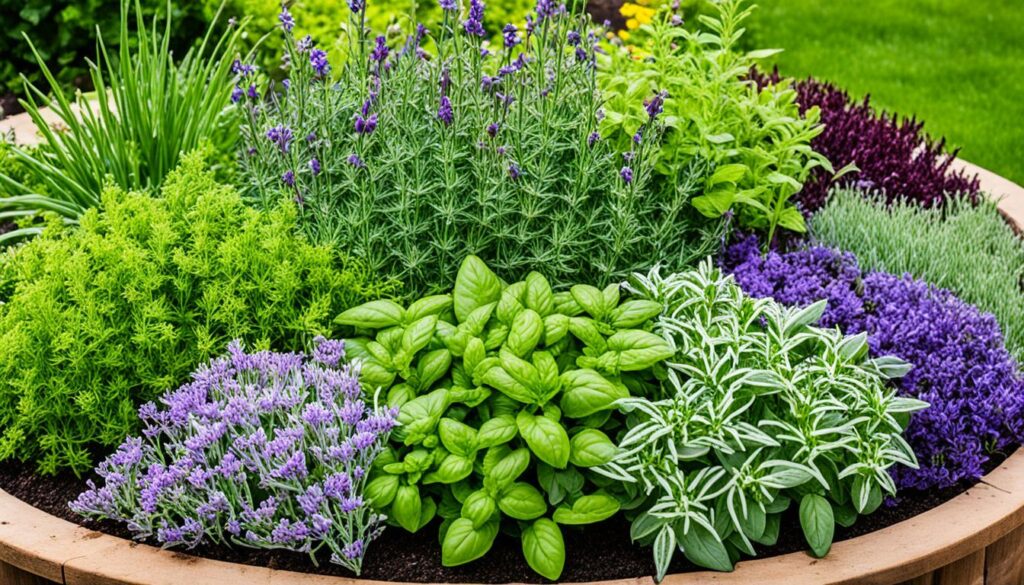
Attracting Beneficial Insects
Planting herbs and flowers can help attract beneficial insects to your garden. These insects can naturally control pests. Aromatic plants like parsley, fennel, and cilantro draw in ladybugs, lacewings, parasitic wasps, and hoverflies. These insects eat aphids, caterpillars, and other pests.
Let these plants flower to attract more beneficial insects. The flowers offer nectar and pollen, which are great food for these insects. This encourages them to live and thrive in your garden.
Parsley, Fennel, and Cilantro
Parsley, fennel, and cilantro are not just tasty herbs. They also help control pests naturally. These plants have small flowers that ladybugs, lacewings, and parasitic wasps love. These insects eat pests like aphids, caterpillars, and mites.
- Parsley attracts hoverflies, which lay eggs near aphids. Their larvae eat the aphids.
- Fennel is a favorite of lacewings. Their larvae eat aphids and mealybugs.
- Cilantro draws parasitic wasps. These wasps lay eggs inside caterpillars, controlling their numbers.
By using these beneficial insects, you can cut down on chemical pesticides. This makes your garden more sustainable and eco-friendly.
Planning Your Companion Planting Strategy
When planning your companion planting strategy, think about what each plant needs and how they work well together. Make sure they like the same amount of light, water, and soil. This way, they’ll grow well together, making your garden healthy and full of life.
Considering Plant Needs and Compatibility
Start by looking at your garden’s conditions like sunlight, moisture, and soil type. Then, find plants that like the same things. For example, put sun-loving herbs like basil, mint, and rosemary with veggies that also need lots of sun. This helps everyone grow better together.
Inspecting Plants and Removing Infested Ones
Checking your plants often is key to a pest-free garden. Look for signs of pests like leaves that are not their usual color, eaten leaves, or bugs. If you find a plant that’s really infested, take it out right away to stop the problem from getting worse. This keeps your companion planting strategy working well.
| Plant Needs | Companion Planting Compatibility |
|---|---|
| Light Requirements | Match sun-loving plants with other sun-loving varieties |
| Water Needs | Pair plants with similar watering requirements |
| Soil Type | Choose plants that thrive in the same soil conditions |
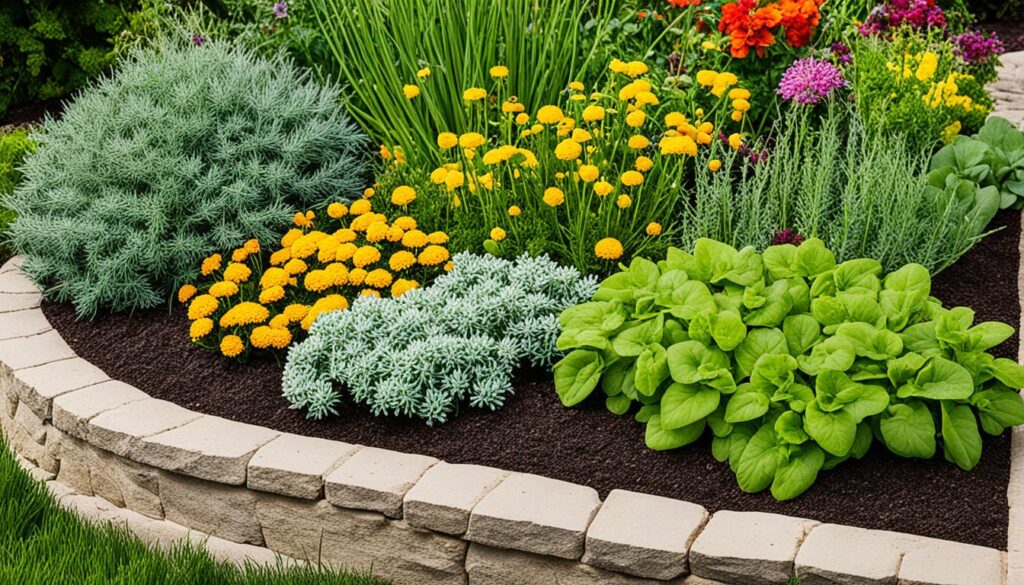
Plan your companion planting strategy well, think about how plants fit together, and watch for pests. This way, you can have a garden that’s full of life and keeps pests away naturally.
Conclusion
Using companion planting can make your garden pest-free without harmful chemicals. By mixing different herbs, flowers, and vegetables, you can keep pests away and attract helpful insects. It might take some trial and error to find the best plant combinations for your garden. But, the long-term benefits of companion planting are worth it for a sustainable, natural pest control.
As you keep improving your companion planting skills, you’ll see a balanced garden ecosystem. Pests will be kept in check, and helpful creatures will flourish. With time and attention, you can cut down on harmful pesticides. This way, you’ll enjoy a pest-free garden that’s full of life.
Now, you know the main ideas and perks of companion planting. You can turn your garden into a lively, eco-friendly haven. Let the variety of plants work together to protect your garden from pests. Enjoy the benefits of a rich, healthy harvest.
FAQ
What are the principles of companion planting for pest control?
The main ideas are: 1) Having more plant types means fewer pests, and 2) Some plants can keep pests away or attract good bugs that eat garden pests.
What are some common herbs that can be used as companion plants to deter pests?
Herbs like mint, tansy, catnip, wormwood, dill, basil, parsley, fennel, and cilantro can keep insects away from vegetables when planted together.
What flowers are effective at attracting beneficial insects to the garden?
Flowers such as nasturtiums, marigolds, cosmos, and alyssum attract ladybugs, lacewings, parasitic wasps, and other good bugs that eat garden pests.
How can I test different companion planting combinations in my garden?
Try pairing thyme, nasturtium, and onion to keep away cabbage worms, or marigold and nasturtium to stop squash bugs. Watch how they do and change things as needed.
Why is it important to avoid using pesticides when practicing companion planting?
Pesticides can hurt good bugs too, upsetting the garden’s balance. Use manual removal, row covers, and healthy soil instead.
What other herbs can be used for natural pest control in the garden?
Herbs like basil, mint, rosemary, lavender, oregano, and thyme can keep away flies, mosquitoes, cabbage worms, and aphids.
How can I attract more beneficial insects to my garden?
Planting parsley, fennel, and cilantro can bring in ladybugs, lacewings, parasitic wasps, and hoverflies that eat garden pests.
What should I consider when planning my companion planting strategy?
Ensure the plants you pair need the same light, water, and soil. Check your garden often for pests and remove any badly infested plants.
Source Links
Top Companion Plant Pairs Every Gardener Should Know
Ever wondered what makes a garden pest-free and thriving? The secret might be in companion planting. But what is it, and how does it boost your gardening success? Learn about the top plant pairs that work together for a harmonious garden.
Key Takeaways
- Companion planting is the strategic pairing of plants that mutually benefit each other
- Certain plant combinations can deter pests, improve soil health, and increase yields
- Knowing the best companion plant pairs can help you create a thriving, low-maintenance garden
- Incorporating flowers and herbs alongside your vegetables can attract pollinators and beneficial insects
- Understanding the science behind companion planting can help you make informed decisions for your garden
What Is Companion Planting?
Companion planting means growing different plants together for mutual benefits. By picking the right plants to grow together, you create a garden that thrives. This method combines ancient farming wisdom with modern science.
Understanding the Benefits of Growing Plants Together
When you practice companion planting, you use the natural strengths of plants. Some plants offer shade or support, while others keep pests away or improve soil. This creates a garden that helps each plant grow better.
- Increased pest resistance through natural pest deterrents
- Enhanced soil fertility from nitrogen-fixing plants or those that attract beneficial insects
- Improved pollination from nectar-rich flowers that attract pollinators
- Greater overall plant health and productivity
Proven Examples of Successful Companion Planting
The Three Sisters method, with corn, beans, and squash, is a classic example. Corn supports the beans, beans enrich the soil, and squash keeps weeds down. This trio shows how plants can work together well.
“Companion planting is nature’s way of minimizing pest damage, boosting soil fertility, reducing weed competition, and, ultimately, increasing yields.”
Evidence-Based Companion Planting Philosophy
Companion planting has grown a lot in recent years. It’s moved from old stories to solid science. Now, thanks to scientific companion planting research, we know which plants work well together.
Before, people thought some veggies had special friends and enemies. But new studies have shown this isn’t always true. They’ve dispelled companion planting myths. Now, we see how plants help each other when grown together.
“The bottom line is that there is simply more evidence for ‘good’ companions than ‘bad’ ones, so the focus is now more on why vegetables need friends.”
Studies show that most plant pairs help each other out. They improve pest control, make nutrients available, and attract pollinators. This proves the benefits of choosing the right evidence-backed plant pairings.
With this evidence-based companion planting philosophy, gardeners can plan their gardens with confidence. They know their plants will grow well together. It’s an exciting time for gardening!
Examples of the Best Companion Plants
Companion planting can greatly benefit your garden. It helps with pest control, plant health, and flavor. Let’s look at some top pairings for your garden.
Basil and Tomatoes: A Classic Combo
Basil and tomatoes are perfect together. Basil keeps away thrips and moths that harm tomatoes. It also brings in bees, which helps pollinate and taste better.
Dill: Attracting Ladybugs to Control Pests
Dill is great for attracting ladybugs. These bugs eat pests like aphids and spider mites. Adding dill near your veggies uses these helpful insects to protect your plants.
Other great beneficial plant pairings include:
- Borage goes well with tomatoes, drawing in bees and making strawberries taste and grow better.
- Garlic and garlic spray keep pests away with their strong smell.
- Mint keeps aphids, ants, and flea beetles away, making it a top choice for pest control.
- Nasturtiums draw caterpillars away from cabbage, broccoli, and kale.
- Parsley brings in beneficial insects to protect and pollinate tomatoes.
Using these successful companion planting examples in your garden creates a healthy, balanced environment. Your plants will thrive and be more productive.
The Science Behind Companion Planting
The study of companion planting is a deep dive into how plants interact with insects and each other. Scientists have found out why some plants work well together. They’ve uncovered the secrets of nature’s clever designs.
Take radishes and pumpkins, for example. When grown together, radishes keep away the squash bug from pumpkins. This happens because radishes release chemicals that pumpkins can absorb. These chemicals protect pumpkins from pests.
Tomatoes and basil are another great pair. Basil’s scent hides the tomatoes from pests. This shows how plants can work together using chemistry.
Leaf shape and arrangement matter too. A mix of leaves can confuse pests, making it hard for them to find their target plant. This helps protect the plant from being eaten.
| Companion Plant Pairing | Scientific Explanation |
|---|---|
| Radishes and Pumpkins | Radishes secrete water-soluble glucosinolates that can be absorbed by pumpkin plants, providing them with natural pest deterrence. |
| Tomatoes and Basil | Basil’s strong aroma helps to disguise the presence of tomato plants, making it harder for pests to locate their desired target. |
| Diverse Leaf Arrangements | A confusing array of leaves can effectively conceal a plant from its would-be predators, as pests may struggle to recognize their host amidst the melee of foliage. |
Studies on companion planting, plant-insect relationships, and plant biochemistry and pest deterrence have given us new insights. They show how plants can help each other grow strong and pest-free. By using these principles, gardeners can create gardens that are full of life and pests.
top companion plant pairs
Companion planting is key to a successful garden. By pairing certain plants, you create a balanced garden. This helps both your veggies and flowers grow well. Let’s look at some top pairings every gardener should know.
Vegetables and Herbs: Tried-and-True Combinations
Basil and tomatoes make a classic pair. Basil improves tomato flavor and keeps pests away. Dill and cucumbers are another great pair. Dill attracts ladybugs that eat aphids, keeping cucumbers healthy.
Flowers and Pollinators: A Mutually Beneficial Relationship
Adding flowers to your garden attracts pollinators and boosts plant health. Flowers like zinnias, cosmos, and marigolds draw bees and butterflies. This flower-pollinator companion plant relationship helps pollinate your veggies and makes your garden lively.
“Companion planting is a time-honored tradition that can transform your garden into a thriving, self-sustaining oasis.”
Common Mistakes in Companion Planting
Companion planting can change the game in the garden, but it has its challenges. Both new and seasoned gardeners need to watch out for common companion planting pitfalls. One big mistake is not thinking about how plants grow. Planting tall crops near short ones can block sunlight and compete for resources.
Another mistake is pairing incompatible plant combinations. Some plants do well together, but others can harm each other. For example, some plants release chemicals that stop nearby plants from growing well.
- Failing to keep plants at the right distance from each other
- Mixing plants with different water and nutrient needs
- Not checking which plants are good “companions”
“The key to successful companion planting is understanding the unique growth habits and requirements of each plant species you wish to grow together.”
By looking into successful plant pairings and considering plant growth habits, gardeners can dodge common mistakes. This way, they can enjoy the benefits of this rewarding gardening method.
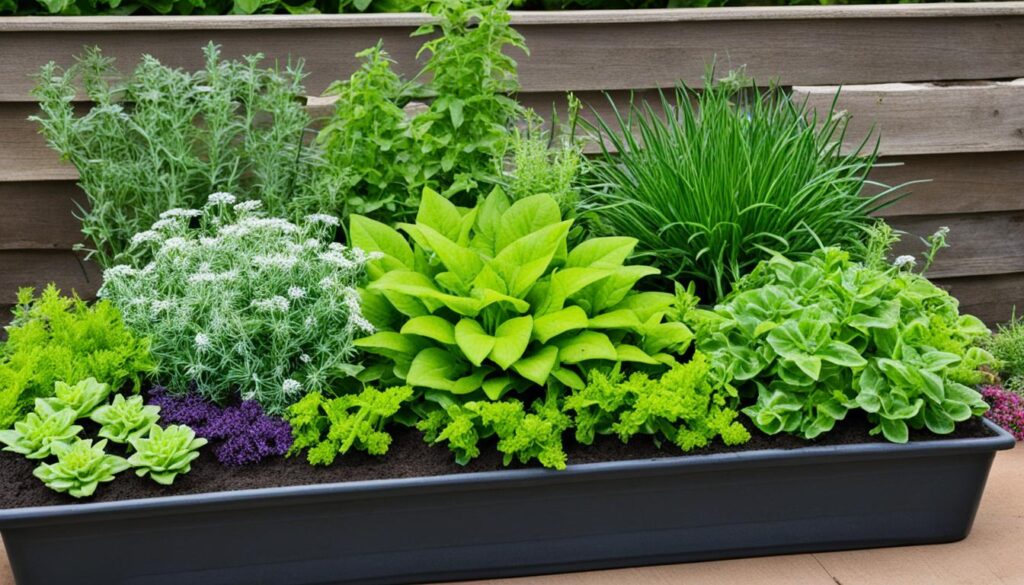
Companion Planting for Pest and Disease Control
Companion planting is a natural way to fight pests and diseases in your garden. Many herbs and flowers have scents or properties that keep pests away. They also draw in beneficial insects that eat pests.
Using Herbs to Repel Pests and Attract Beneficials
Herbs like garlic, mint, and marigolds have strong smells that pests don’t like. Planting these near your veggies can keep pests away. This helps protect your plants.
Some herbs and flowers also bring in good bugs that eat pests. For instance, dill and borage attract ladybugs and other insects that eat aphids and other pests.
| Herb | Pest Repellent | Beneficial Insect Attractor |
|---|---|---|
| Garlic | Aphids, beetles, rodents | – |
| Mint | Aphids, ants, cabbage worms | – |
| Marigolds | Nematodes, aphids, beetles | – |
| Dill | – | Ladybugs, lacewings |
| Borage | – | Bees, lacewings |
By adding these companion plants for pest management to your garden, you make a balanced ecosystem. This approach naturally keeps pests away and brings in beneficial insects. It makes your garden healthier and more sustainable.
“Companion planting is all about creating a diverse, self-sustaining garden ecosystem that works in harmony to control pests and diseases naturally.”
Incorporating Flowers into Your Vegetable Garden
Adding flowers as companion plants to your vegetable garden brings many benefits. They make your garden look great and help keep pests away. Pollinator-attracting flowers like nasturtiums, marigolds, and zinnias draw in good insects that eat garden pests.
When picking flowers for companion planting, think about when they bloom, how much sun and water they need, and how big they get. This way, your flowers and vegetables will work well together. They’ll make your garden a healthy, diverse place.
Flowers for Pest Control and Pollination
- Marigolds keep pests like aphids, nematodes, and rabbits away. They’re a great ornamental for pest control.
- Nasturtiums draw in ladybugs and lacewings. These insects eat aphids and other pests.
- Zinnias are easy to care for and pollinators love them. They help pollinate your vegetables.
By adding different kinds of pollinator-attracting flowers to your garden, you make a great place for your plants and local wildlife.
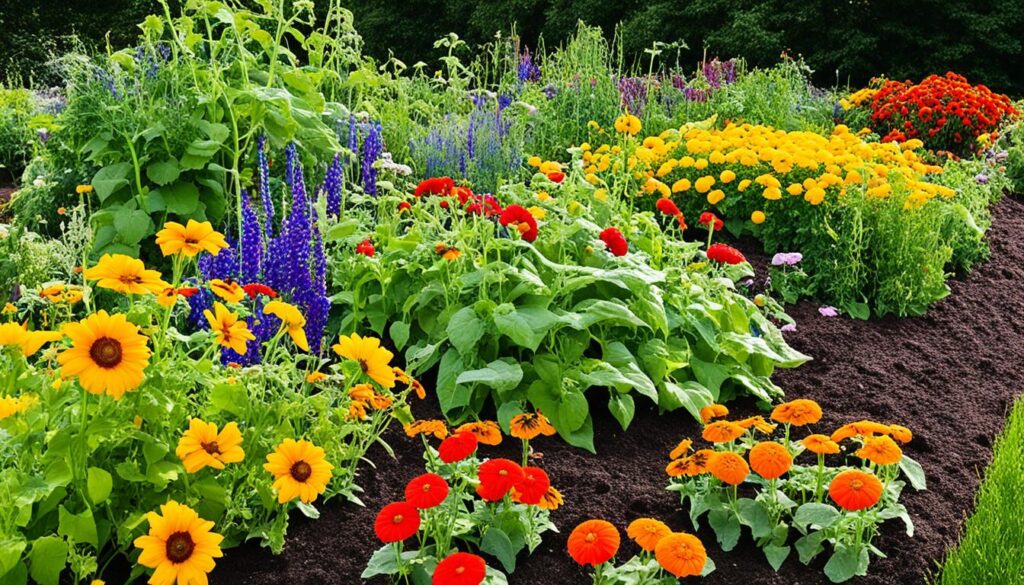
“A well-designed flower border can be both beautiful and functional, providing valuable habitat and resources for beneficial insects while enhancing the overall health and productivity of your vegetable garden.”
Bad Neighbors: Plants to Avoid Planting Together
Companion planting pairs plants to work well together in the garden. But, some plants don’t get along and should be kept apart. Knowing which plants clash is key to a healthy garden.
One big reason to keep some plants apart is they compete for things like nutrients and sunlight. Plants that fight over these resources shouldn’t be planted together. For instance, zucchini and winter squash vines can overshadow lettuce, making it hard for the lettuce to grow.
It’s also smart to keep plants that get the same diseases apart. This stops one sick plant from spreading its illness to others. So, tomatoes and potatoes shouldn’t be side by side since they can both get the same fungal diseases.
| Incompatible Plant Combinations | Reason for Avoiding |
|---|---|
| Zucchini or Winter Squash vs. Lettuce | Competition for resources (nutrients, water, space, sunlight) |
| Tomatoes vs. Potatoes | Susceptibility to the same diseases (e.g., fungal infections) |
| Brassicas (Cabbage, Broccoli, Cauliflower) vs. Tomatoes | Allelopathic effects (release of chemicals that inhibit growth of other plants) |
By knowing which plants don’t mix well, gardeners can grow a garden that’s full of life and productivity. This way, they make the most of planting together while avoiding problems with plant relationships.
Conclusion
Companion planting is a key gardening method that makes your garden better. It pairs plants together to keep pests away, improve soil, and draw in helpful insects. This approach boosts your garden’s productivity and looks.
It doesn’t matter if you’re growing veggies, herbs, or flowers. Using companion planting leads to more food and a healthier garden. You can try pairing basil with tomatoes or find new ones to see what works best.
Every garden is different, so try out various plant combinations. Watch how they interact and change things as needed. With a diverse garden, you get a space that’s easy to care for and supports both you and local wildlife.
FAQ
What is companion planting?
Companion planting means growing plants together that help each other out. This method stops diseases, keeps pests away, and gives shade to other plants. It makes your garden healthier and more productive.
What are the benefits of companion planting?
It cuts down on pesticides, draws in pollinators, enriches the soil, and boosts your harvest. It’s a smart way to build a garden that’s full of life and needs less care.
What are some examples of successful companion plant pairings?
Great pairs include basil with tomatoes, dill with ladybugs, and borage with strawberries. Zinnias, cosmos, and marigolds also attract good bugs to your veggies.
Is there scientific evidence to support companion planting?
Yes, studies show that certain plants grow better together. They can fight pests, grow faster, and help wildlife. We’re learning more about how plants help each other out.
What are some common mistakes to avoid in companion planting?
Don’t pick plants with big roots that might compete, plant them too close, or ignore how they grow. Make sure to check which plants work well together before you start your garden.
How can companion planting help with pest and disease control?
Herbs like garlic, mint, and marigolds keep pests away with their strong smells. Planting them with veggies helps control pests. Some plants, like dill and borage, bring in good bugs that fight pests and boost crops.
What are some good flower choices for companion planting?
Flowers such as nasturtiums, marigolds, and zinnias keep pests away and draw in helpful insects. Pick flowers that match your veggies in sun, water, and growth needs for the best results.
Which plants should not be planted together?
Don’t plant plants that fight over resources like nutrients, water, space, and sunlight. Keep plants that get the same diseases apart to stop disease from spreading.
Source Links
The Ultimate Guide to Companion Planting: How to Pair Plants for a Healthier Garden
Did you know pairing certain plants can boost your garden’s health and productivity? Welcome to the world of companion planting, a technique used for centuries. This guide will show you how to make your backyard thrive.
By placing vegetables, herbs, and flowers together, you can fight pests and improve growth and flavor naturally. This method is a great way to make your garden healthier. You’ll learn about the best plants to pair for a healthy garden.
Get ready to see how companion planting can change your garden. It’s great for both new and experienced gardeners. This guide will give you the knowledge to improve your planting combinations.
Introduction
Companion planting is a key strategy for gardeners wanting to increase their harvest naturally. It matches plants that help each other, making your garden healthier. For beginners, it’s a great way to boost your garden’s health without using chemicals.
Organic gardening companion plants work together to keep pests away, improve soil, and taste better. By placing herbs near vegetables or flowers, you’re copying nature’s defense. This approach protects your plants and draws in helpful insects like pollinators.
Planning your garden with companion planting in mind takes some thought. But the benefits are huge. Think about:
- Plant compatibility
- Growth habits
- Nutrient needs
With careful planning, you’ll grow a diverse, strong garden that supports each plant. Let’s see how plant partnerships can make your garden healthier and more productive.
| Benefits of Companion Planting | Examples |
|---|---|
| Pest Control | Marigolds repel tomato hornworms |
| Improved Flavor | Basil enhances tomato taste |
| Nutrient Boost | Beans fix nitrogen for corn |
| Space Optimization | Lettuce grows under taller plants |
What is Companion Planting?
Companion planting is a smart way to grow plants together to help each other grow and keep pests away. This method has been used for a long time, thanks to Native American farmers. By picking the right plants to grow together, you can make your garden better for all your plants.
Definition and History
Companion planting means growing different plants side by side for their mutual benefits. It’s an old idea that goes way back. Native Americans used the “Three Sisters” method, growing corn, beans, and squash together.

How It Works
When plants grow together, they interact in many ways. Some help each other out physically, while others make the soil better or keep pests away. For instance, corn acts as a trellis for beans, which fix nitrogen in the soil. Squash spreads out and keeps weeds down, helping to keep the soil moist.
Benefits Overview
Companion planting has many benefits for your garden:
- Natural pest control
- Improved pollination
- Efficient use of space
- Enhanced soil health
- Better flavor in crops
| Plant Pair | Benefit |
|---|---|
| Tomatoes + Basil | Pest repellent, flavor enhancement |
| Carrots + Onions | Pest control, space optimization |
| Marigolds + Vegetables | Pest deterrent, soil improvement |
Learning about companion planting lets you create a garden that works well on its own. The secret is to know how plants help each other. Then, use this knowledge in your garden for the best results.
The Science Behind Companion Planting
Companion planting research shows us how plants work together. It uses nature’s own ways to help plants grow and defend themselves. By knowing these connections, you can make your garden better.
Plants talk to each other with chemical signals. Some send out signals that keep pests away or draw in helpful insects. For instance, marigolds send out signals that keep nematodes away, protecting other plants.
Soil gets better with companion planting too. Some plants, like legumes, can fix nitrogen in the soil. When you plant beans with corn, the beans make the soil richer, helping the corn grow better. This shows how planting together can make soil healthier without using chemicals.
Recent studies have found even more about how plants work together. Some plants make their neighbors grow better. Basil, for example, makes tomatoes taste better and grow stronger when planted near them. These discoveries let us plan gardens that work better together.
“Companion planting is like orchestrating a symphony in your garden. Each plant plays its part, contributing to a harmonious and thriving ecosystem.”
Using these scientific ideas, you can make your garden stronger and more productive. Companion planting uses nature’s ways to make gardens healthier and more sustainable. It cuts down on the need for artificial help.
Essential Companion Plant Pairs
Pairing plants wisely can make your garden healthier and more productive. A good companion planting chart helps you pick the best plants for your garden. Let’s look at some great pairings that are perfect for vegetables.
Tomato and Basil: A Classic Duo
Tomatoes and basil are a perfect pair. Basil keeps pests away from tomatoes and makes them taste better. Plant basil near your tomatoes to keep pests away and boost your harvest.
Carrots and Onions: Underground Allies
Onions and carrots work well together. Onions keep carrot flies away, protecting your carrots. This combo is great for small gardens because it uses space well.
Beans and Corn: The Three Sisters Method
Beans and corn are part of the “Three Sisters” method. Beans add nitrogen to the soil for corn. Corn helps bean vines grow by providing a trellis.
| Companion Plant | Benefits | Plant Near |
|---|---|---|
| Marigolds | Pest repellent | Most vegetables |
| Nasturtiums | Attract pollinators | Cucumbers, squash |
| Garlic | Deters pests | Roses, fruit trees |
Some plants don’t mix well together. Keep potatoes and tomatoes separate to stop diseases from spreading. With these tips and a good companion planting chart, you’ll have a garden that’s full of life and variety.
Companion Planting for Pest Control
Companion planting is a great way for gardeners to fight pests naturally. It matches plants that help each other stay pest-free. This method makes gardens healthier without using harsh chemicals.
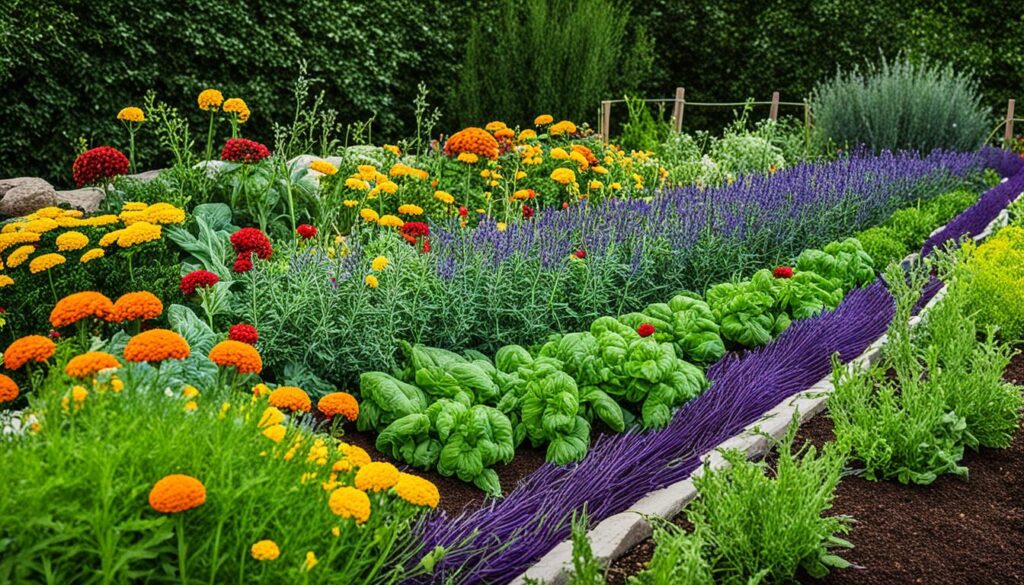
Some plants naturally keep pests away from others. For instance, basil near tomatoes can fend off tomato hornworms. Marigolds are heroes, keeping many pests away with their strong smell.
Here’s a list of plants that keep pests away:
- Garlic: Repels Japanese beetles and aphids
- Nasturtiums: Keep aphids and beetles away
- Chives: Deter aphids and Japanese beetles
Using these plants can cut down on chemical pesticides. This not only protects your plants but also helps your garden’s ecosystem stay balanced.
| Companion Plant | Pest Repelled | Protected Plant |
|---|---|---|
| Basil | Tomato hornworms | Tomatoes |
| Marigolds | Various garden pests | Most vegetables |
| Garlic | Japanese beetles, aphids | Roses, fruit trees |
| Nasturtiums | Aphids, beetles | Cucumbers, squash |
| Chives | Aphids, Japanese beetles | Carrots, tomatoes |
For successful companion planting, plan carefully. Think about what each plant needs and how they work together. With the right combinations, you can make a garden that’s full of life and pests.
Companion Planting for Soil Health

Companion planting does more than fight pests. It’s a key way to make your garden soil better. By choosing the right plant partners, you can improve soil health and make your garden more productive.
Legumes are great for the soil. Beans and peas work with bacteria to fix nitrogen in the soil. This makes the soil richer, helping other plants grow and cutting down on the need for chemical fertilizers.
Deep-rooted plants like comfrey are important for improving soil. They loosen hard soil, helping water and air get through. These plants also pull nutrients from deep in the soil and share them with other plants when they break down.
Cover crops are another smart move for gardeners. They stop soil from washing away and add organic stuff to the soil when tilled in. This makes the soil better for your plants to grow well.
| Plant | Soil Benefit | Companion Plants |
|---|---|---|
| Beans | Nitrogen fixation | Corn, Squash |
| Comfrey | Nutrient accumulation | Fruit trees, Tomatoes |
| Clover | Erosion control | Brassicas, Cucumbers |
Using these companion planting methods, you’re not just growing plants. You’re building a healthy garden ecosystem. This way of taking care of soil is key to having strong, healthy plants and lots of food.
Seasonal Companion Planting
Seasonal gardening becomes more exciting with companion planting. This method pairs plants that grow well together at different times. By choosing the right plant friends, your garden will flourish all year round.
Pairing fast-growing crops with slower ones is a smart move. Radishes and carrots work well together. Radishes grow quickly and don’t take up much space, making room for the carrots.
Cool-season crops love the shade of taller plants. Lettuce grows well under tomato plants’ shade. This combo uses space wisely and helps lettuce grow in the heat.
| Season | Companion Planting Combination | Benefits |
|---|---|---|
| Spring | Peas and Radishes | Radishes mark pea rows and are harvested before peas mature |
| Summer | Tomatoes and Basil | Basil repels pests and enhances tomato flavor |
| Fall | Broccoli and Lettuce | Broccoli provides shade for lettuce in cooling temperatures |
| Winter | Garlic and Spinach | Garlic deters pests while spinach utilizes space efficiently |
Using these strategies, your garden will be diverse and productive all year. Try out different plant combinations to see what works best in your garden.
Common Mistakes and How to Avoid Them
Even seasoned gardeners can make mistakes with companion planting. Knowing these common errors can help you avoid mistakes and boost your gardening skills.
One big mistake is putting plants together that don’t get along. For instance, putting sun-loving crops under the shade of tall plants can slow their growth. Always research what each plant needs and plan your garden carefully.
Another issue is overcrowding your garden. When plants are too close, they fight over water and nutrients. Think about how big each plant will get before you plant them to give them enough room.
Not rotating your crops every year is also a mistake. It can make the soil poor and bring diseases. Use a crop rotation plan to keep the soil healthy and stop pests.
| Common Mistake | How to Avoid |
|---|---|
| Incompatible plant pairings | Research plant needs before planting |
| Overcrowding | Consider mature plant sizes |
| Neglecting crop rotation | Implement annual rotation system |
| Ignoring root systems | Pair plants with complementary root structures |
By avoiding these common mistakes and using companion planting tips, you can make a garden that flourishes. Always watch your plants and adjust as needed for the best growth and health.
Advanced Companion Planting Techniques
Are you ready to boost your garden? Let’s dive into advanced gardening techniques that will change how you plant together. These methods are more than just pairing plants. They create gardens that are diverse and strong.
Polyculture is a big step up in companion planting. It means growing many crops together, like in nature. This way, you use your land better and get more from your garden. You can grow tall plants with shade-loving ones underneath.
Trap cropping is a smart trick. It uses certain plants to draw pests away from your main crops. Nasturtiums are great for this, pulling aphids away from your veggies.
Living trellises take companion planting further. Use strong plants like corn or sunflowers to support climbers like pole beans or peas. This method saves space and makes your garden look great and work well.
| Technique | Benefits | Examples |
|---|---|---|
| Polyculture | Increased yield, pest resistance | Corn, beans, squash (Three Sisters planting) |
| Trap Cropping | Natural pest control | Nasturtiums to protect vegetables |
| Living Trellises | Space-saving, vertical growth | Corn supporting pole beans |
| Living Mulch | Weed suppression, moisture retention | Low-growing herbs around vegetables |
Using these advanced planting strategies will make your garden a thriving ecosystem. Try these out to see what’s best for your garden.
Conclusion
Companion planting changes the game for your garden. By pairing plants smartly, you boost your garden’s health and yield. This method brings many benefits, like natural pest control and better soil health.
You don’t need to be an expert to start. Just mix and match plants based on their needs and how they grow. Some pairings are scientifically proven, while others come from gardening wisdom. The main thing is to keep trying new combinations in your garden.
Adopting companion planting is a step towards sustainable gardening. It makes gardens more resilient and productive. By doing this, you’re not just growing plants. You’re creating a thriving ecosystem in your backyard.
So, get ready to plant! Your garden will reward you with healthier plants, fewer pests, and a big harvest. Every garden is different, so enjoy finding what works best for yours.
FAQ
What is companion planting?
Companion planting means growing plants together to help each other out. It’s about placing vegetables, herbs, and flowers in a way that makes them work well together. This creates good relationships in the garden.
What are the benefits of companion planting?
It helps keep pests away, brings in good bugs, makes plants grow better and taste sweeter. It also cuts down on pesticides, draws in pollinators, improves soil, and increases how much you can harvest.
What is the Three Sisters planting method?
The Three Sisters method is a way of planting where corn, beans, and squash grow together. The corn helps the beans climb up it, the beans make the soil richer with nitrogen, and the squash keeps the ground cool and weed-free.
How does companion planting help with pest control?
Some plants make chemicals that keep pests away or bring in good bugs. For example, basil keeps tomato hornworms away, and marigolds keep many garden pests off.
Can companion planting improve soil health?
Yes, plants like beans and peas add nitrogen to the soil, helping other plants. Deep-rooted plants loosen hard soil, and some, like comfrey, make nutrients easier for other plants to get.
What are some essential companion plant pairs?
Important pairs include tomatoes with basil, carrots with onions, beans with corn, peppers with basil, marigolds with most vegetables, and nasturtiums all over the garden.
What are some common mistakes in companion planting?
Don’t plant things that don’t go well together, don’t crowd them, and think about how big they’ll get. Doing your homework and planning carefully helps avoid these mistakes.
What are some advanced companion planting techniques?
Advanced methods include growing many crops together, using some plants to distract pests from others, and using plants as trellises or ground covers.
Source Links
- https://www.marthastewart.com/8379510/companion-planting-guide – Use Our Companion Planting Chart to Grow a Thriving Vegetable Garden
- https://www.budgetdumpster.com/blog/companion-planting-guide – A Beginner’s Guide to Companion Planting in the Garden
- https://www.parkseed.com/blog/the-ultimate-guide-to-companion-planting-vegetables – The Ultimate Guide to Companion Planting Vegetables
- 10 Must-Have Blooms for Your 2025 Garden
- The Health Advantages of Gardening You Need to Know
- How to Create a Small Vegetable Garden Layout Plan: A Beginner’s Guide
- DIY Garden Projects for Small Spaces: Upcycling Ideas to Maximize Your Garden
- Watering Techniques for Small Gardens: Ensuring Your Plants Thrive
- Small Border Plants for Landscaping: Adding Beauty and Functionality to Your Garden
- Year-Round Small Space Gardening: Seasonal Planting Tips for Maximum Harvest
- Essential Tools for Small-Space Gardening: What You Really Need
- The Ultimate Guide to Container Vegetables: What to Grow in Small Spaces
- Budget-Friendly Gardening: How to Create a Thriving Garden on a Tight Budget
- How to Optimize Sunlight in Small Gardens: Tips for Better Plant Growth
- DIY Vertical Planters: Creative Ideas for Small Space Gardening
- Companion Planting for Small Vegetable Gardens: Boost Growth and Deter Pests
- Container Gardening Essentials: Choosing the Right Pots, Soil, and Plants
- Vertical Gardening Techniques: Maximizing Your Small Space with Climbers and Vines
- How to Build a Raised Bed Garden in a Small Backyard: Step-by-Step Guide
- The Best Vegetables for Small-Space Gardens: High-Yield Varieties You Need to Grow
- Smart Vegetable Garden Layouts for Small Spaces: Maximizing Your Green Thumb in Compact Areas
- 40. Best Practices for Managing a Sustainable Garden Year-Round
- Building a Wildlife Pond for Biodiversity
- Advanced Techniques in Sustainable Gardening
- How to Create a No-Till Garden
- The Mental Health Benefits of Gardening
- Using Technology to Enhance Sustainable Gardening
- Getting Certified Organic: Steps and Benefits
